Competitive Analysis of IAG and CGU in the Australian General Insurance Industry
VerifiedAdded on 2019/09/24
|18
|4618
|252
Report
AI Summary
The provided content is a collection of academic articles and industry reports related to business strategy, leadership, and sustainability. The articles explore various topics such as the balanced scorecard, McKinsey 7-S model, blue ocean strategy, sustainable competitive advantage, and financial security in uncertain operating environments. Additionally, there are reports from IBIS World, MarketLine, and Geert Hofstede that provide insights into the Australian general insurance industry, companies like IAG and CGU, and cultural aspects of Australia. The content appears to be a comprehensive collection of resources for business studies.
Contribute Materials
Your contribution can guide someone’s learning journey. Share your
documents today.
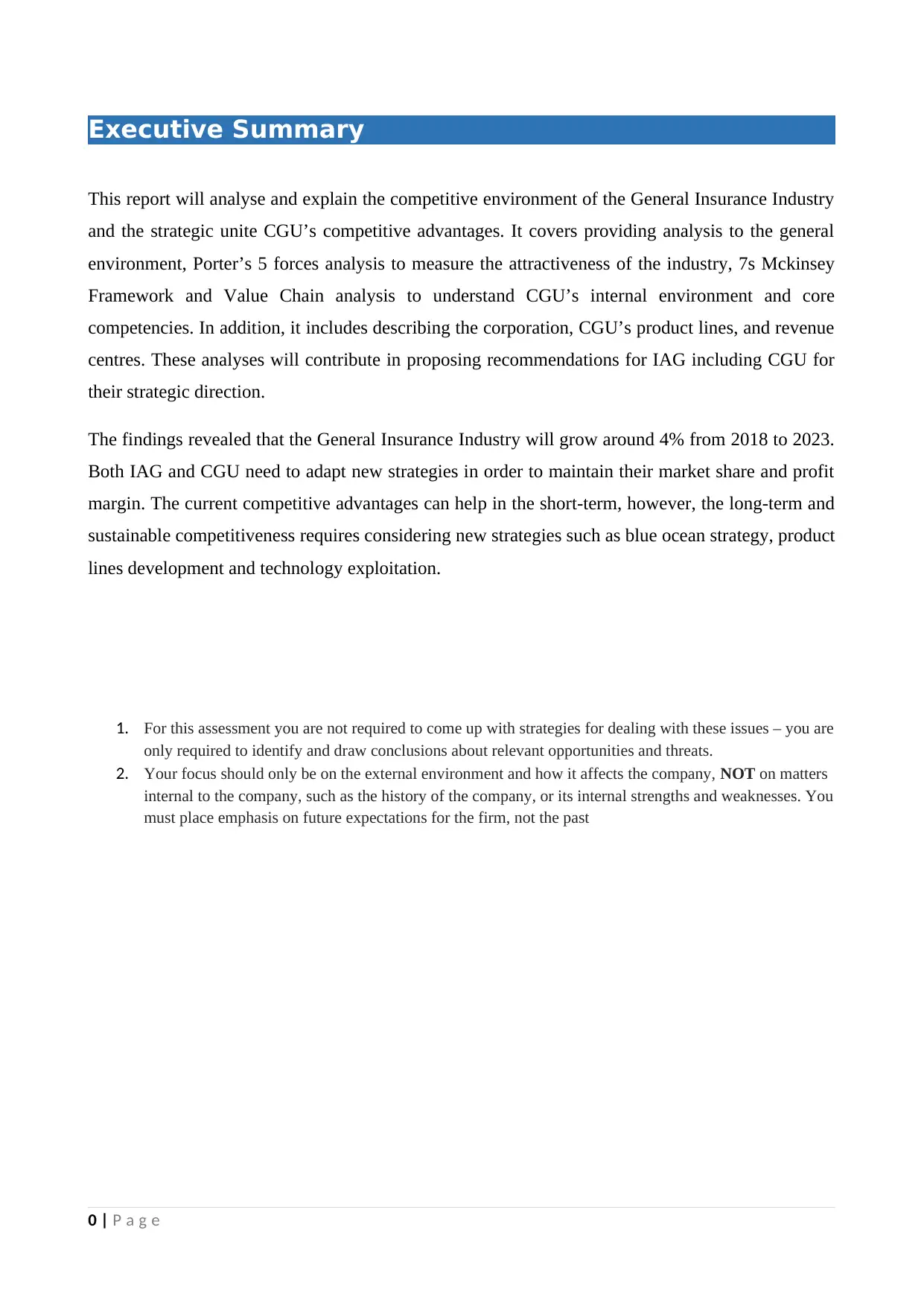
Executive Summary
This report will analyse and explain the competitive environment of the General Insurance Industry
and the strategic unite CGU’s competitive advantages. It covers providing analysis to the general
environment, Porter’s 5 forces analysis to measure the attractiveness of the industry, 7s Mckinsey
Framework and Value Chain analysis to understand CGU’s internal environment and core
competencies. In addition, it includes describing the corporation, CGU’s product lines, and revenue
centres. These analyses will contribute in proposing recommendations for IAG including CGU for
their strategic direction.
The findings revealed that the General Insurance Industry will grow around 4% from 2018 to 2023.
Both IAG and CGU need to adapt new strategies in order to maintain their market share and profit
margin. The current competitive advantages can help in the short-term, however, the long-term and
sustainable competitiveness requires considering new strategies such as blue ocean strategy, product
lines development and technology exploitation.
1. For this assessment you are not required to come up with strategies for dealing with these issues – you are
only required to identify and draw conclusions about relevant opportunities and threats.
2. Your focus should only be on the external environment and how it affects the company, NOT on matters
internal to the company, such as the history of the company, or its internal strengths and weaknesses. You
must place emphasis on future expectations for the firm, not the past
0 | P a g e
This report will analyse and explain the competitive environment of the General Insurance Industry
and the strategic unite CGU’s competitive advantages. It covers providing analysis to the general
environment, Porter’s 5 forces analysis to measure the attractiveness of the industry, 7s Mckinsey
Framework and Value Chain analysis to understand CGU’s internal environment and core
competencies. In addition, it includes describing the corporation, CGU’s product lines, and revenue
centres. These analyses will contribute in proposing recommendations for IAG including CGU for
their strategic direction.
The findings revealed that the General Insurance Industry will grow around 4% from 2018 to 2023.
Both IAG and CGU need to adapt new strategies in order to maintain their market share and profit
margin. The current competitive advantages can help in the short-term, however, the long-term and
sustainable competitiveness requires considering new strategies such as blue ocean strategy, product
lines development and technology exploitation.
1. For this assessment you are not required to come up with strategies for dealing with these issues – you are
only required to identify and draw conclusions about relevant opportunities and threats.
2. Your focus should only be on the external environment and how it affects the company, NOT on matters
internal to the company, such as the history of the company, or its internal strengths and weaknesses. You
must place emphasis on future expectations for the firm, not the past
0 | P a g e
Secure Best Marks with AI Grader
Need help grading? Try our AI Grader for instant feedback on your assignments.
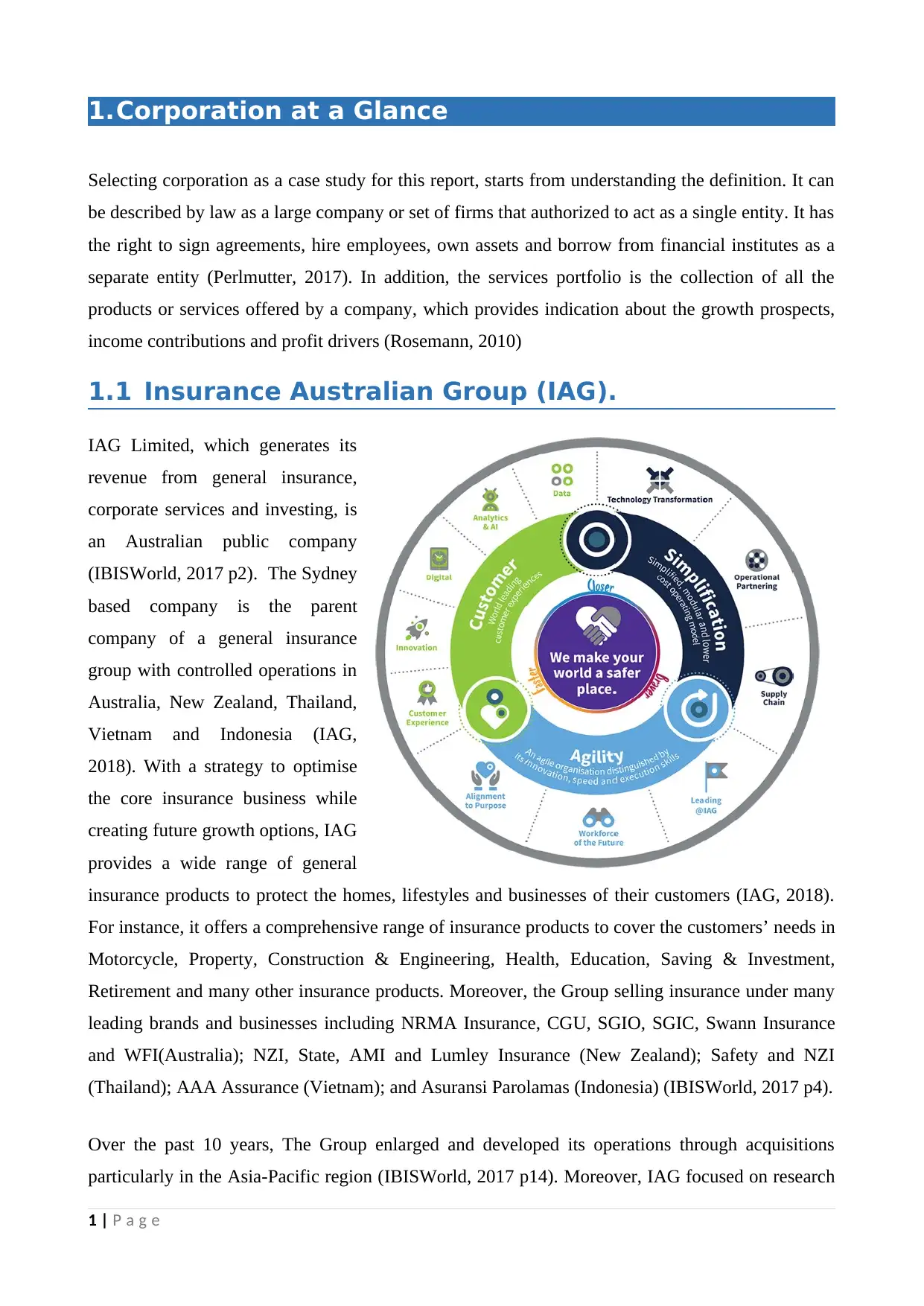
1.Corporation at a Glance
Selecting corporation as a case study for this report, starts from understanding the definition. It can
be described by law as a large company or set of firms that authorized to act as a single entity. It has
the right to sign agreements, hire employees, own assets and borrow from financial institutes as a
separate entity (Perlmutter, 2017). In addition, the services portfolio is the collection of all the
products or services offered by a company, which provides indication about the growth prospects,
income contributions and profit drivers (Rosemann, 2010)
1.1 Insurance Australian Group (IAG).
IAG Limited, which generates its
revenue from general insurance,
corporate services and investing, is
an Australian public company
(IBISWorld, 2017 p2). The Sydney
based company is the parent
company of a general insurance
group with controlled operations in
Australia, New Zealand, Thailand,
Vietnam and Indonesia (IAG,
2018). With a strategy to optimise
the core insurance business while
creating future growth options, IAG
provides a wide range of general
insurance products to protect the homes, lifestyles and businesses of their customers (IAG, 2018).
For instance, it offers a comprehensive range of insurance products to cover the customers’ needs in
Motorcycle, Property, Construction & Engineering, Health, Education, Saving & Investment,
Retirement and many other insurance products. Moreover, the Group selling insurance under many
leading brands and businesses including NRMA Insurance, CGU, SGIO, SGIC, Swann Insurance
and WFI(Australia); NZI, State, AMI and Lumley Insurance (New Zealand); Safety and NZI
(Thailand); AAA Assurance (Vietnam); and Asuransi Parolamas (Indonesia) (IBISWorld, 2017 p4).
Over the past 10 years, The Group enlarged and developed its operations through acquisitions
particularly in the Asia-Pacific region (IBISWorld, 2017 p14). Moreover, IAG focused on research
1 | P a g e
Selecting corporation as a case study for this report, starts from understanding the definition. It can
be described by law as a large company or set of firms that authorized to act as a single entity. It has
the right to sign agreements, hire employees, own assets and borrow from financial institutes as a
separate entity (Perlmutter, 2017). In addition, the services portfolio is the collection of all the
products or services offered by a company, which provides indication about the growth prospects,
income contributions and profit drivers (Rosemann, 2010)
1.1 Insurance Australian Group (IAG).
IAG Limited, which generates its
revenue from general insurance,
corporate services and investing, is
an Australian public company
(IBISWorld, 2017 p2). The Sydney
based company is the parent
company of a general insurance
group with controlled operations in
Australia, New Zealand, Thailand,
Vietnam and Indonesia (IAG,
2018). With a strategy to optimise
the core insurance business while
creating future growth options, IAG
provides a wide range of general
insurance products to protect the homes, lifestyles and businesses of their customers (IAG, 2018).
For instance, it offers a comprehensive range of insurance products to cover the customers’ needs in
Motorcycle, Property, Construction & Engineering, Health, Education, Saving & Investment,
Retirement and many other insurance products. Moreover, the Group selling insurance under many
leading brands and businesses including NRMA Insurance, CGU, SGIO, SGIC, Swann Insurance
and WFI(Australia); NZI, State, AMI and Lumley Insurance (New Zealand); Safety and NZI
(Thailand); AAA Assurance (Vietnam); and Asuransi Parolamas (Indonesia) (IBISWorld, 2017 p4).
Over the past 10 years, The Group enlarged and developed its operations through acquisitions
particularly in the Asia-Pacific region (IBISWorld, 2017 p14). Moreover, IAG focused on research
1 | P a g e
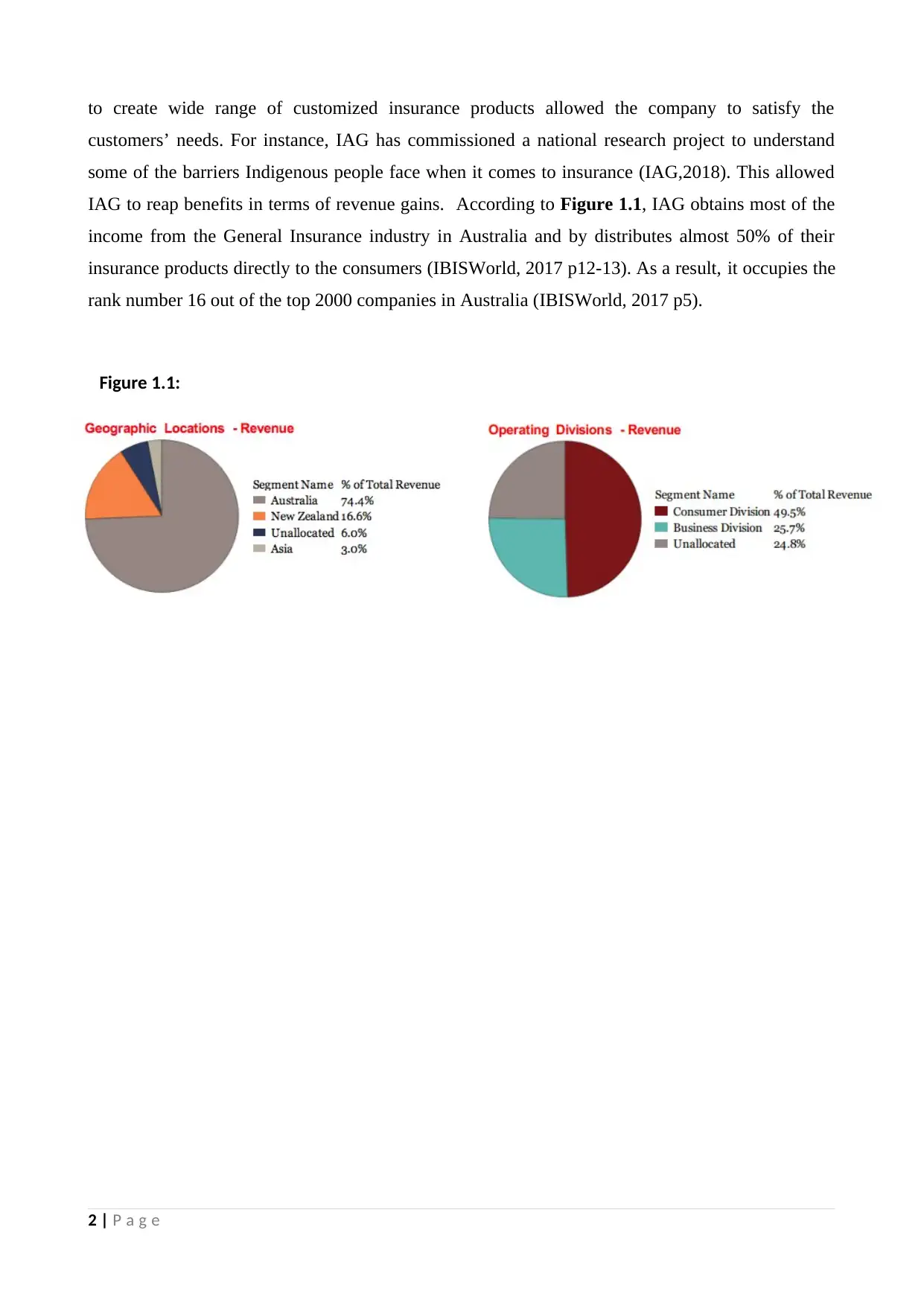
to create wide range of customized insurance products allowed the company to satisfy the
customers’ needs. For instance, IAG has commissioned a national research project to understand
some of the barriers Indigenous people face when it comes to insurance (IAG,2018). This allowed
IAG to reap benefits in terms of revenue gains. According to Figure 1.1, IAG obtains most of the
income from the General Insurance industry in Australia and by distributes almost 50% of their
insurance products directly to the consumers (IBISWorld, 2017 p12-13). As a result, it occupies the
rank number 16 out of the top 2000 companies in Australia (IBISWorld, 2017 p5).
Figure 1.1:
2 | P a g e
customers’ needs. For instance, IAG has commissioned a national research project to understand
some of the barriers Indigenous people face when it comes to insurance (IAG,2018). This allowed
IAG to reap benefits in terms of revenue gains. According to Figure 1.1, IAG obtains most of the
income from the General Insurance industry in Australia and by distributes almost 50% of their
insurance products directly to the consumers (IBISWorld, 2017 p12-13). As a result, it occupies the
rank number 16 out of the top 2000 companies in Australia (IBISWorld, 2017 p5).
Figure 1.1:
2 | P a g e
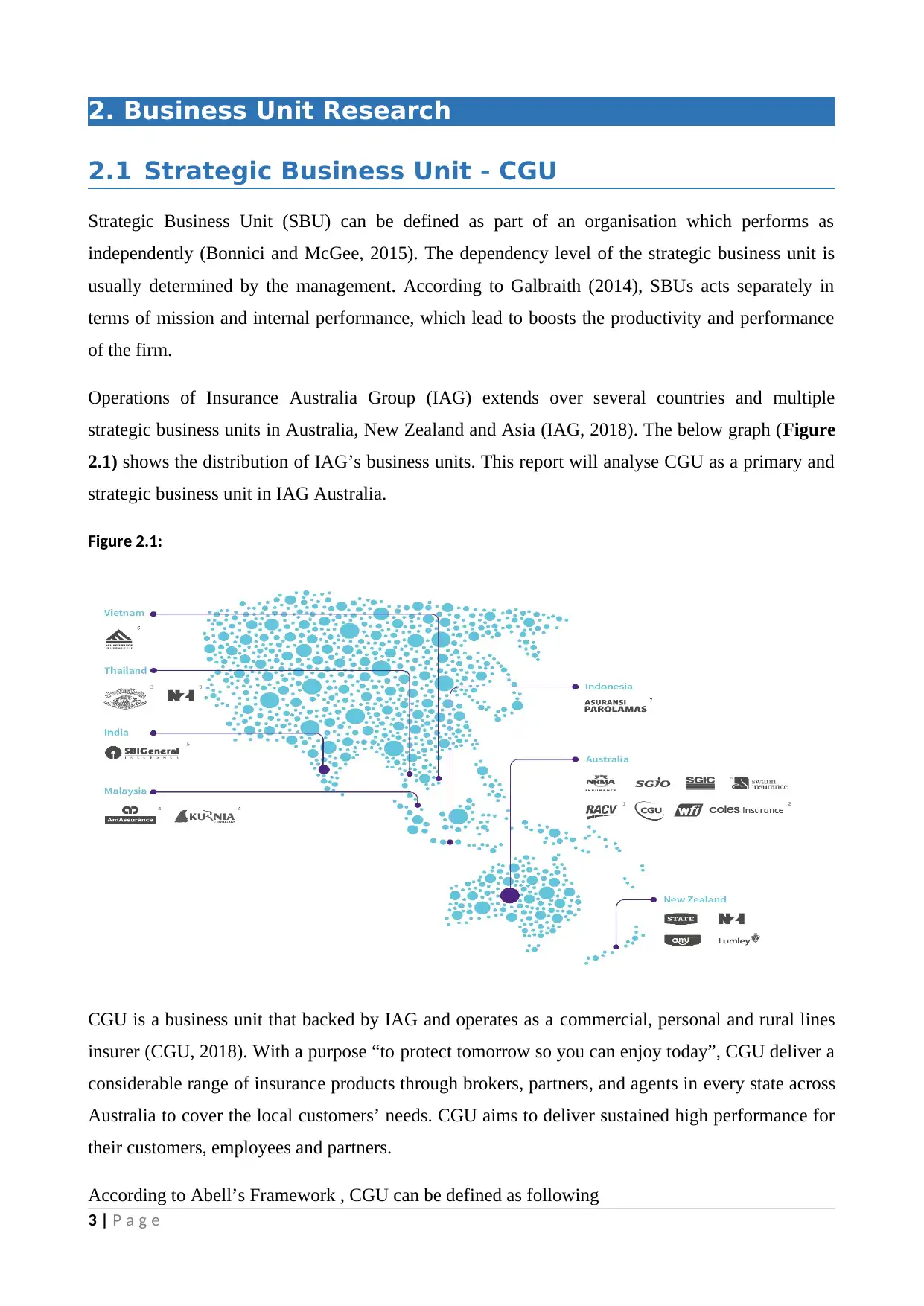
2. Business Unit Research
2.1 Strategic Business Unit - CGU
Strategic Business Unit (SBU) can be defined as part of an organisation which performs as
independently (Bonnici and McGee, 2015). The dependency level of the strategic business unit is
usually determined by the management. According to Galbraith (2014), SBUs acts separately in
terms of mission and internal performance, which lead to boosts the productivity and performance
of the firm.
Operations of Insurance Australia Group (IAG) extends over several countries and multiple
strategic business units in Australia, New Zealand and Asia (IAG, 2018). The below graph (Figure
2.1) shows the distribution of IAG’s business units. This report will analyse CGU as a primary and
strategic business unit in IAG Australia.
Figure 2.1:
CGU is a business unit that backed by IAG and operates as a commercial, personal and rural lines
insurer (CGU, 2018). With a purpose “to protect tomorrow so you can enjoy today”, CGU deliver a
considerable range of insurance products through brokers, partners, and agents in every state across
Australia to cover the local customers’ needs. CGU aims to deliver sustained high performance for
their customers, employees and partners.
According to Abell’s Framework , CGU can be defined as following
3 | P a g e
2.1 Strategic Business Unit - CGU
Strategic Business Unit (SBU) can be defined as part of an organisation which performs as
independently (Bonnici and McGee, 2015). The dependency level of the strategic business unit is
usually determined by the management. According to Galbraith (2014), SBUs acts separately in
terms of mission and internal performance, which lead to boosts the productivity and performance
of the firm.
Operations of Insurance Australia Group (IAG) extends over several countries and multiple
strategic business units in Australia, New Zealand and Asia (IAG, 2018). The below graph (Figure
2.1) shows the distribution of IAG’s business units. This report will analyse CGU as a primary and
strategic business unit in IAG Australia.
Figure 2.1:
CGU is a business unit that backed by IAG and operates as a commercial, personal and rural lines
insurer (CGU, 2018). With a purpose “to protect tomorrow so you can enjoy today”, CGU deliver a
considerable range of insurance products through brokers, partners, and agents in every state across
Australia to cover the local customers’ needs. CGU aims to deliver sustained high performance for
their customers, employees and partners.
According to Abell’s Framework , CGU can be defined as following
3 | P a g e
Secure Best Marks with AI Grader
Need help grading? Try our AI Grader for instant feedback on your assignments.
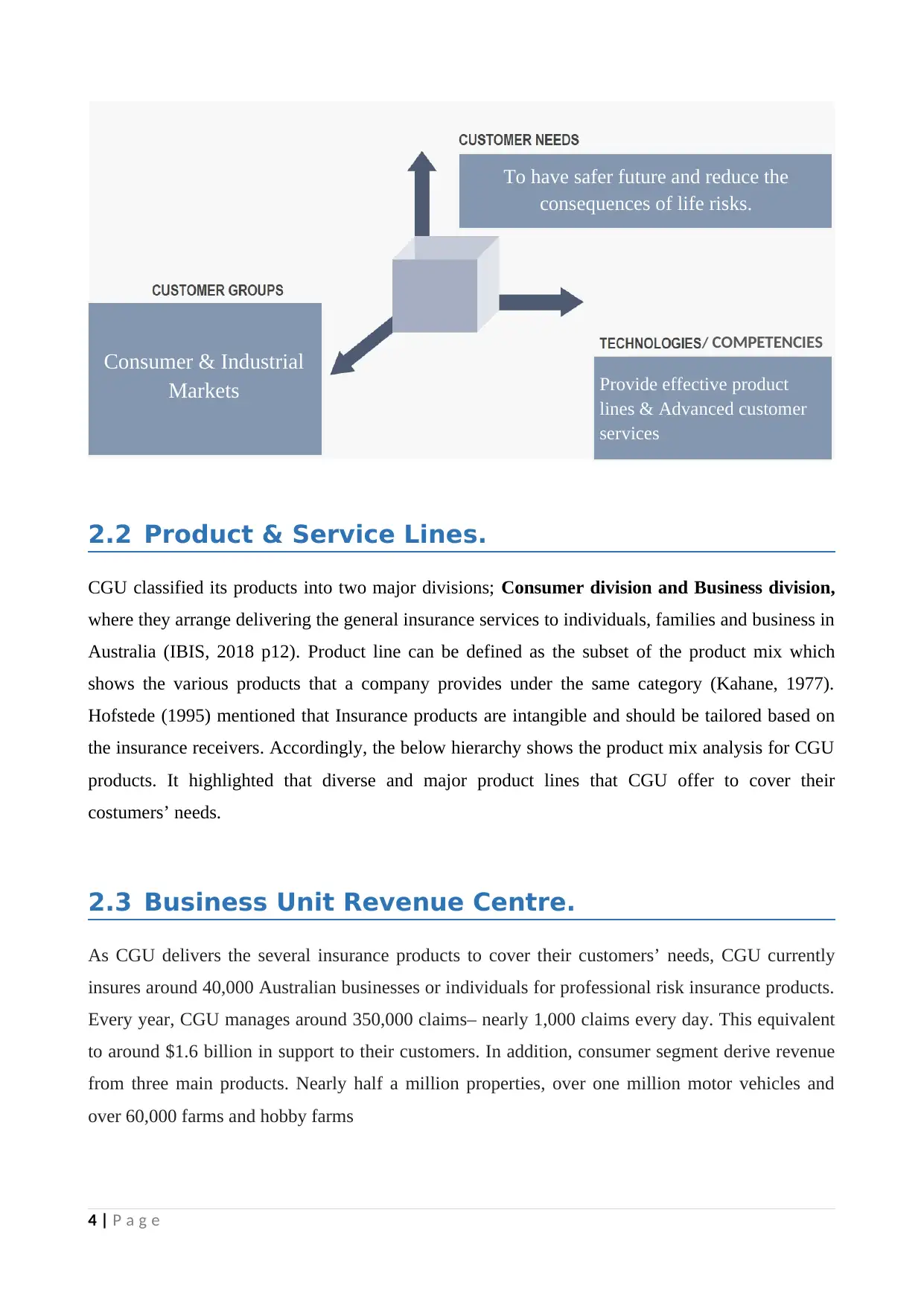
/ COMPETENCIES
2.2 Product & Service Lines.
CGU classified its products into two major divisions; Consumer division and Business division,
where they arrange delivering the general insurance services to individuals, families and business in
Australia (IBIS, 2018 p12). Product line can be defined as the subset of the product mix which
shows the various products that a company provides under the same category (Kahane, 1977).
Hofstede (1995) mentioned that Insurance products are intangible and should be tailored based on
the insurance receivers. Accordingly, the below hierarchy shows the product mix analysis for CGU
products. It highlighted that diverse and major product lines that CGU offer to cover their
costumers’ needs.
2.3 Business Unit Revenue Centre.
As CGU delivers the several insurance products to cover their customers’ needs, CGU currently
insures around 40,000 Australian businesses or individuals for professional risk insurance products.
Every year, CGU manages around 350,000 claims– nearly 1,000 claims every day. This equivalent
to around $1.6 billion in support to their customers. In addition, consumer segment derive revenue
from three main products. Nearly half a million properties, over one million motor vehicles and
over 60,000 farms and hobby farms
4 | P a g e
Consumer & Industrial
Markets
To have safer future and reduce the
consequences of life risks.
Provide effective product
lines & Advanced customer
services
2.2 Product & Service Lines.
CGU classified its products into two major divisions; Consumer division and Business division,
where they arrange delivering the general insurance services to individuals, families and business in
Australia (IBIS, 2018 p12). Product line can be defined as the subset of the product mix which
shows the various products that a company provides under the same category (Kahane, 1977).
Hofstede (1995) mentioned that Insurance products are intangible and should be tailored based on
the insurance receivers. Accordingly, the below hierarchy shows the product mix analysis for CGU
products. It highlighted that diverse and major product lines that CGU offer to cover their
costumers’ needs.
2.3 Business Unit Revenue Centre.
As CGU delivers the several insurance products to cover their customers’ needs, CGU currently
insures around 40,000 Australian businesses or individuals for professional risk insurance products.
Every year, CGU manages around 350,000 claims– nearly 1,000 claims every day. This equivalent
to around $1.6 billion in support to their customers. In addition, consumer segment derive revenue
from three main products. Nearly half a million properties, over one million motor vehicles and
over 60,000 farms and hobby farms
4 | P a g e
Consumer & Industrial
Markets
To have safer future and reduce the
consequences of life risks.
Provide effective product
lines & Advanced customer
services

5 | P a g e
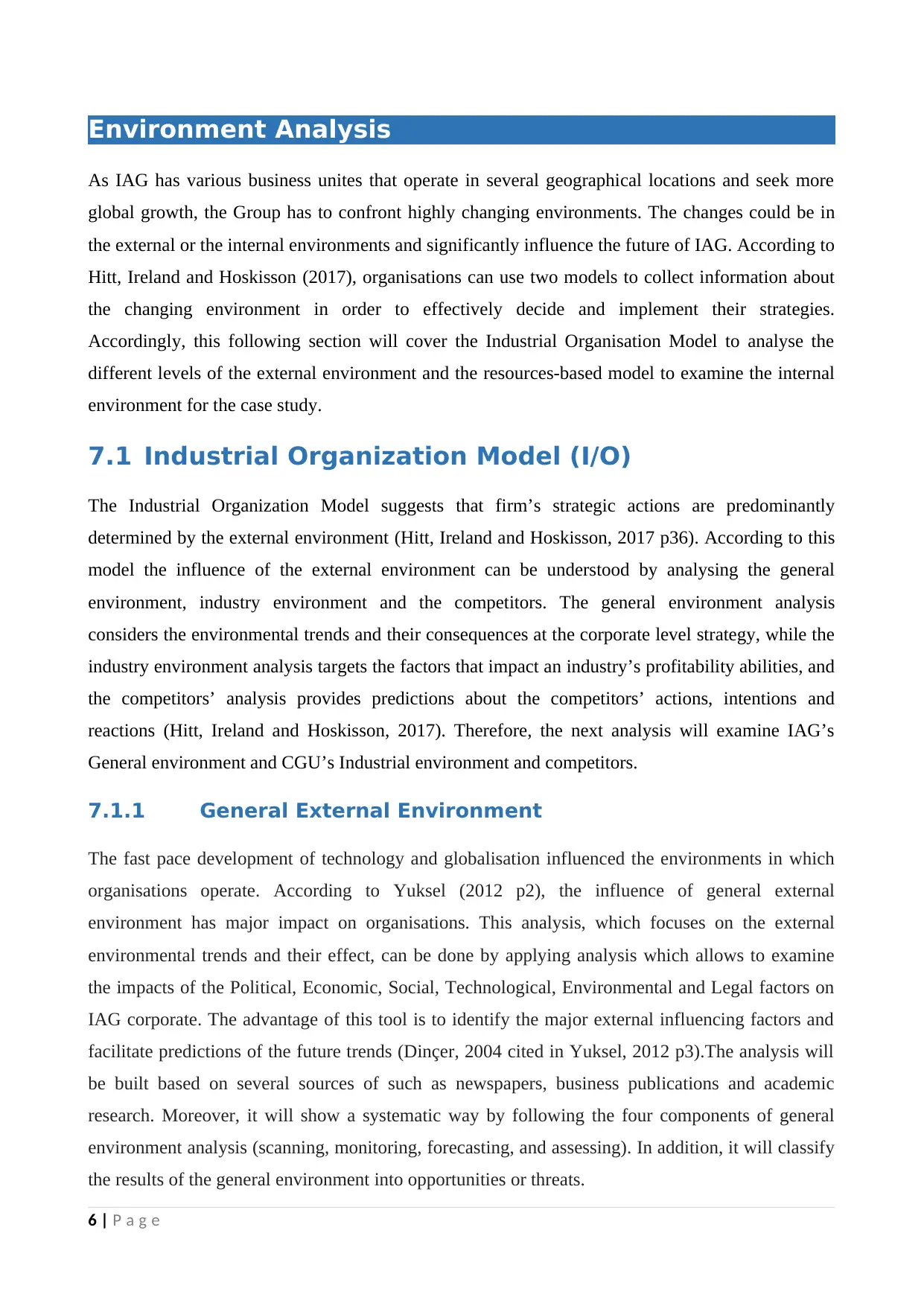
Environment Analysis
As IAG has various business unites that operate in several geographical locations and seek more
global growth, the Group has to confront highly changing environments. The changes could be in
the external or the internal environments and significantly influence the future of IAG. According to
Hitt, Ireland and Hoskisson (2017), organisations can use two models to collect information about
the changing environment in order to effectively decide and implement their strategies.
Accordingly, this following section will cover the Industrial Organisation Model to analyse the
different levels of the external environment and the resources-based model to examine the internal
environment for the case study.
7.1 Industrial Organization Model (I/O)
The Industrial Organization Model suggests that firm’s strategic actions are predominantly
determined by the external environment (Hitt, Ireland and Hoskisson, 2017 p36). According to this
model the influence of the external environment can be understood by analysing the general
environment, industry environment and the competitors. The general environment analysis
considers the environmental trends and their consequences at the corporate level strategy, while the
industry environment analysis targets the factors that impact an industry’s profitability abilities, and
the competitors’ analysis provides predictions about the competitors’ actions, intentions and
reactions (Hitt, Ireland and Hoskisson, 2017). Therefore, the next analysis will examine IAG’s
General environment and CGU’s Industrial environment and competitors.
7.1.1 General External Environment
The fast pace development of technology and globalisation influenced the environments in which
organisations operate. According to Yuksel (2012 p2), the influence of general external
environment has major impact on organisations. This analysis, which focuses on the external
environmental trends and their effect, can be done by applying analysis which allows to examine
the impacts of the Political, Economic, Social, Technological, Environmental and Legal factors on
IAG corporate. The advantage of this tool is to identify the major external influencing factors and
facilitate predictions of the future trends (Dinçer, 2004 cited in Yuksel, 2012 p3).The analysis will
be built based on several sources of such as newspapers, business publications and academic
research. Moreover, it will show a systematic way by following the four components of general
environment analysis (scanning, monitoring, forecasting, and assessing). In addition, it will classify
the results of the general environment into opportunities or threats.
6 | P a g e
As IAG has various business unites that operate in several geographical locations and seek more
global growth, the Group has to confront highly changing environments. The changes could be in
the external or the internal environments and significantly influence the future of IAG. According to
Hitt, Ireland and Hoskisson (2017), organisations can use two models to collect information about
the changing environment in order to effectively decide and implement their strategies.
Accordingly, this following section will cover the Industrial Organisation Model to analyse the
different levels of the external environment and the resources-based model to examine the internal
environment for the case study.
7.1 Industrial Organization Model (I/O)
The Industrial Organization Model suggests that firm’s strategic actions are predominantly
determined by the external environment (Hitt, Ireland and Hoskisson, 2017 p36). According to this
model the influence of the external environment can be understood by analysing the general
environment, industry environment and the competitors. The general environment analysis
considers the environmental trends and their consequences at the corporate level strategy, while the
industry environment analysis targets the factors that impact an industry’s profitability abilities, and
the competitors’ analysis provides predictions about the competitors’ actions, intentions and
reactions (Hitt, Ireland and Hoskisson, 2017). Therefore, the next analysis will examine IAG’s
General environment and CGU’s Industrial environment and competitors.
7.1.1 General External Environment
The fast pace development of technology and globalisation influenced the environments in which
organisations operate. According to Yuksel (2012 p2), the influence of general external
environment has major impact on organisations. This analysis, which focuses on the external
environmental trends and their effect, can be done by applying analysis which allows to examine
the impacts of the Political, Economic, Social, Technological, Environmental and Legal factors on
IAG corporate. The advantage of this tool is to identify the major external influencing factors and
facilitate predictions of the future trends (Dinçer, 2004 cited in Yuksel, 2012 p3).The analysis will
be built based on several sources of such as newspapers, business publications and academic
research. Moreover, it will show a systematic way by following the four components of general
environment analysis (scanning, monitoring, forecasting, and assessing). In addition, it will classify
the results of the general environment into opportunities or threats.
6 | P a g e
Paraphrase This Document
Need a fresh take? Get an instant paraphrase of this document with our AI Paraphraser
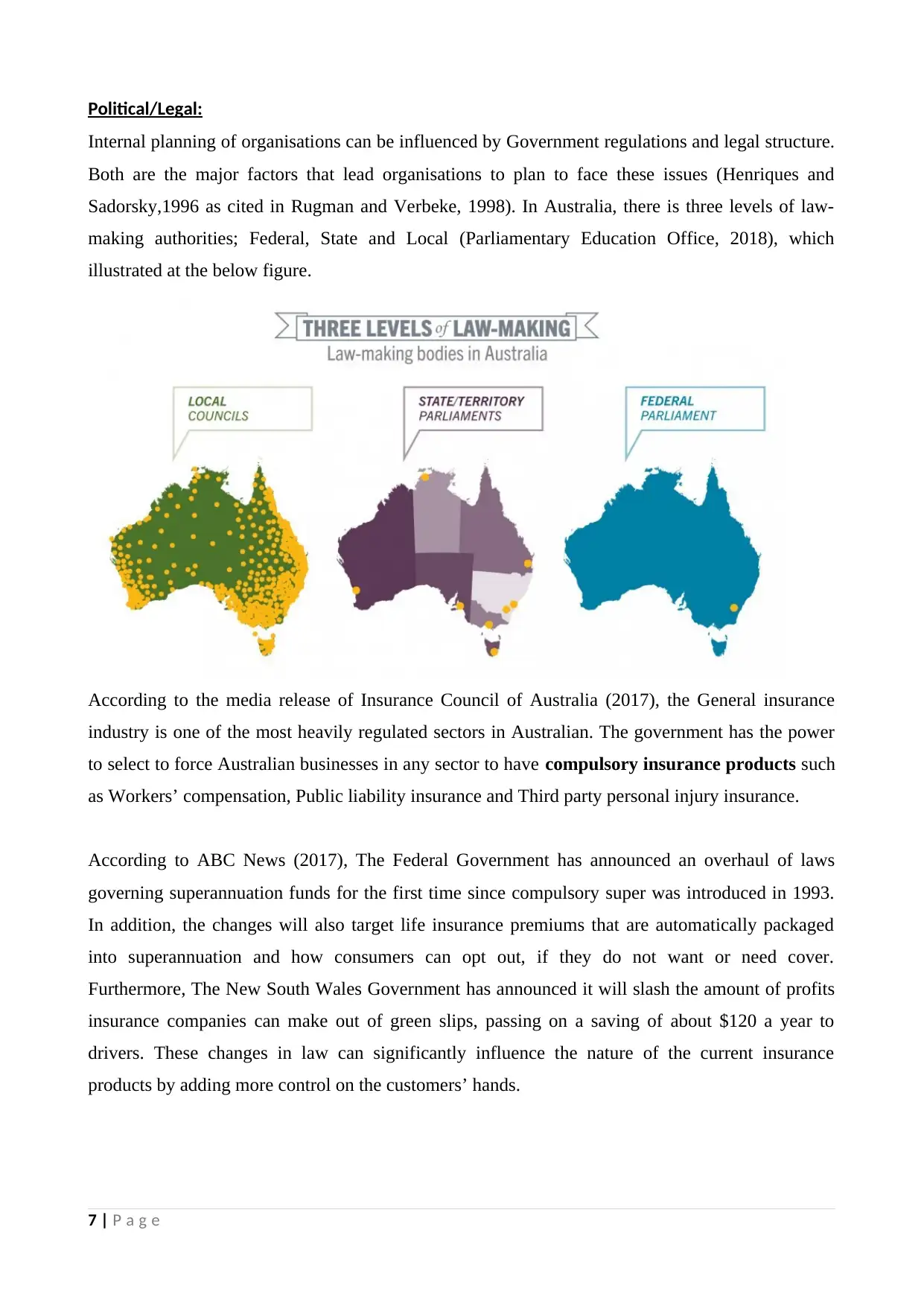
Political/Legal:
Internal planning of organisations can be influenced by Government regulations and legal structure.
Both are the major factors that lead organisations to plan to face these issues (Henriques and
Sadorsky,1996 as cited in Rugman and Verbeke, 1998). In Australia, there is three levels of law-
making authorities; Federal, State and Local (Parliamentary Education Office, 2018), which
illustrated at the below figure.
According to the media release of Insurance Council of Australia (2017), the General insurance
industry is one of the most heavily regulated sectors in Australian. The government has the power
to select to force Australian businesses in any sector to have compulsory insurance products such
as Workers’ compensation, Public liability insurance and Third party personal injury insurance.
According to ABC News (2017), The Federal Government has announced an overhaul of laws
governing superannuation funds for the first time since compulsory super was introduced in 1993.
In addition, the changes will also target life insurance premiums that are automatically packaged
into superannuation and how consumers can opt out, if they do not want or need cover.
Furthermore, The New South Wales Government has announced it will slash the amount of profits
insurance companies can make out of green slips, passing on a saving of about $120 a year to
drivers. These changes in law can significantly influence the nature of the current insurance
products by adding more control on the customers’ hands.
7 | P a g e
Internal planning of organisations can be influenced by Government regulations and legal structure.
Both are the major factors that lead organisations to plan to face these issues (Henriques and
Sadorsky,1996 as cited in Rugman and Verbeke, 1998). In Australia, there is three levels of law-
making authorities; Federal, State and Local (Parliamentary Education Office, 2018), which
illustrated at the below figure.
According to the media release of Insurance Council of Australia (2017), the General insurance
industry is one of the most heavily regulated sectors in Australian. The government has the power
to select to force Australian businesses in any sector to have compulsory insurance products such
as Workers’ compensation, Public liability insurance and Third party personal injury insurance.
According to ABC News (2017), The Federal Government has announced an overhaul of laws
governing superannuation funds for the first time since compulsory super was introduced in 1993.
In addition, the changes will also target life insurance premiums that are automatically packaged
into superannuation and how consumers can opt out, if they do not want or need cover.
Furthermore, The New South Wales Government has announced it will slash the amount of profits
insurance companies can make out of green slips, passing on a saving of about $120 a year to
drivers. These changes in law can significantly influence the nature of the current insurance
products by adding more control on the customers’ hands.
7 | P a g e
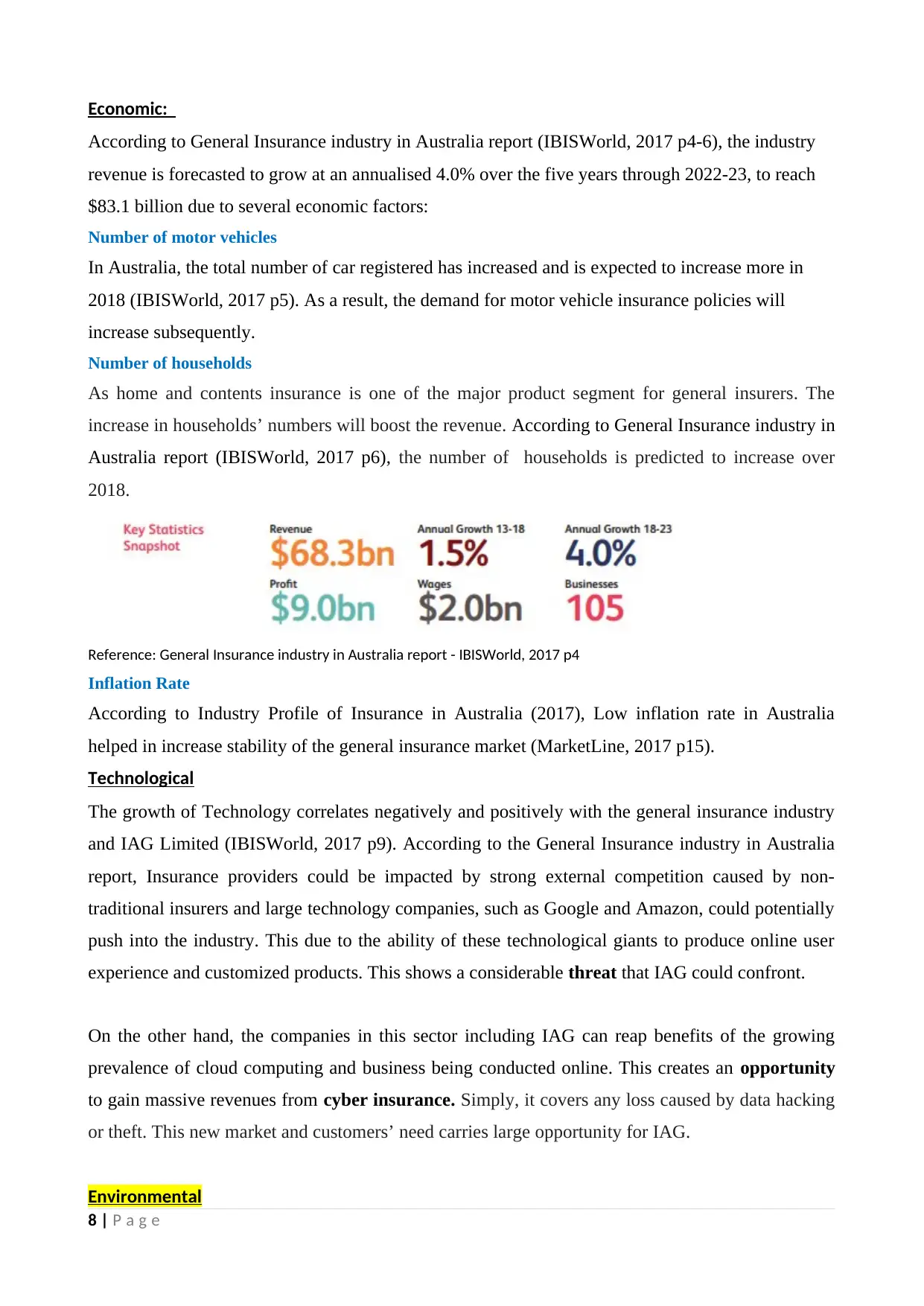
Economic:
According to General Insurance industry in Australia report (IBISWorld, 2017 p4-6), the industry
revenue is forecasted to grow at an annualised 4.0% over the five years through 2022-23, to reach
$83.1 billion due to several economic factors:
Number of motor vehicles
In Australia, the total number of car registered has increased and is expected to increase more in
2018 (IBISWorld, 2017 p5). As a result, the demand for motor vehicle insurance policies will
increase subsequently.
Number of households
As home and contents insurance is one of the major product segment for general insurers. The
increase in households’ numbers will boost the revenue. According to General Insurance industry in
Australia report (IBISWorld, 2017 p6), the number of households is predicted to increase over
2018.
Reference: General Insurance industry in Australia report - IBISWorld, 2017 p4
Inflation Rate
According to Industry Profile of Insurance in Australia (2017), Low inflation rate in Australia
helped in increase stability of the general insurance market (MarketLine, 2017 p15).
Technological
The growth of Technology correlates negatively and positively with the general insurance industry
and IAG Limited (IBISWorld, 2017 p9). According to the General Insurance industry in Australia
report, Insurance providers could be impacted by strong external competition caused by non-
traditional insurers and large technology companies, such as Google and Amazon, could potentially
push into the industry. This due to the ability of these technological giants to produce online user
experience and customized products. This shows a considerable threat that IAG could confront.
On the other hand, the companies in this sector including IAG can reap benefits of the growing
prevalence of cloud computing and business being conducted online. This creates an opportunity
to gain massive revenues from cyber insurance. Simply, it covers any loss caused by data hacking
or theft. This new market and customers’ need carries large opportunity for IAG.
Environmental
8 | P a g e
According to General Insurance industry in Australia report (IBISWorld, 2017 p4-6), the industry
revenue is forecasted to grow at an annualised 4.0% over the five years through 2022-23, to reach
$83.1 billion due to several economic factors:
Number of motor vehicles
In Australia, the total number of car registered has increased and is expected to increase more in
2018 (IBISWorld, 2017 p5). As a result, the demand for motor vehicle insurance policies will
increase subsequently.
Number of households
As home and contents insurance is one of the major product segment for general insurers. The
increase in households’ numbers will boost the revenue. According to General Insurance industry in
Australia report (IBISWorld, 2017 p6), the number of households is predicted to increase over
2018.
Reference: General Insurance industry in Australia report - IBISWorld, 2017 p4
Inflation Rate
According to Industry Profile of Insurance in Australia (2017), Low inflation rate in Australia
helped in increase stability of the general insurance market (MarketLine, 2017 p15).
Technological
The growth of Technology correlates negatively and positively with the general insurance industry
and IAG Limited (IBISWorld, 2017 p9). According to the General Insurance industry in Australia
report, Insurance providers could be impacted by strong external competition caused by non-
traditional insurers and large technology companies, such as Google and Amazon, could potentially
push into the industry. This due to the ability of these technological giants to produce online user
experience and customized products. This shows a considerable threat that IAG could confront.
On the other hand, the companies in this sector including IAG can reap benefits of the growing
prevalence of cloud computing and business being conducted online. This creates an opportunity
to gain massive revenues from cyber insurance. Simply, it covers any loss caused by data hacking
or theft. This new market and customers’ need carries large opportunity for IAG.
Environmental
8 | P a g e
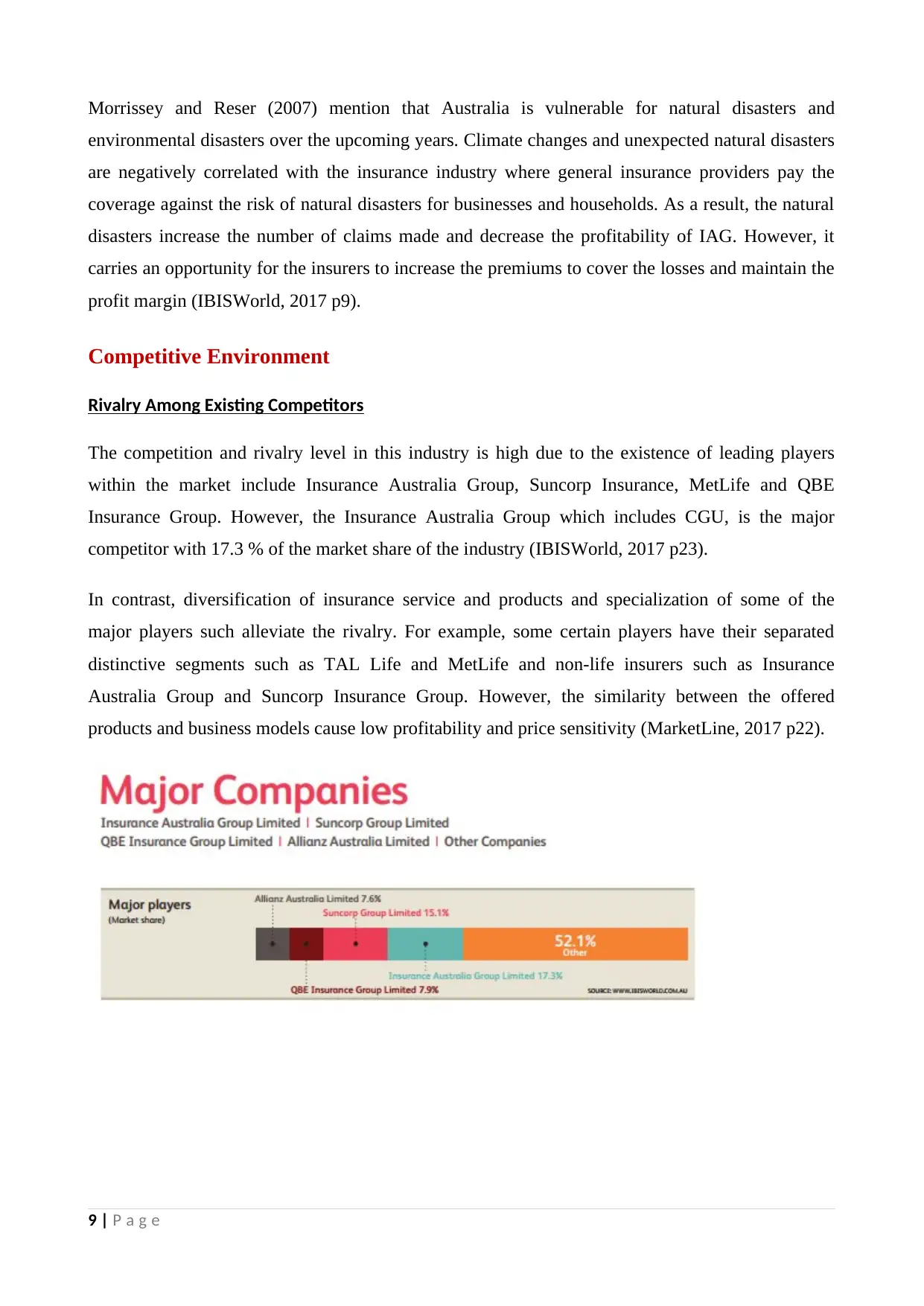
Morrissey and Reser (2007) mention that Australia is vulnerable for natural disasters and
environmental disasters over the upcoming years. Climate changes and unexpected natural disasters
are negatively correlated with the insurance industry where general insurance providers pay the
coverage against the risk of natural disasters for businesses and households. As a result, the natural
disasters increase the number of claims made and decrease the profitability of IAG. However, it
carries an opportunity for the insurers to increase the premiums to cover the losses and maintain the
profit margin (IBISWorld, 2017 p9).
Competitive Environment
Rivalry Among Existing Competitors
The competition and rivalry level in this industry is high due to the existence of leading players
within the market include Insurance Australia Group, Suncorp Insurance, MetLife and QBE
Insurance Group. However, the Insurance Australia Group which includes CGU, is the major
competitor with 17.3 % of the market share of the industry (IBISWorld, 2017 p23).
In contrast, diversification of insurance service and products and specialization of some of the
major players such alleviate the rivalry. For example, some certain players have their separated
distinctive segments such as TAL Life and MetLife and non-life insurers such as Insurance
Australia Group and Suncorp Insurance Group. However, the similarity between the offered
products and business models cause low profitability and price sensitivity (MarketLine, 2017 p22).
9 | P a g e
environmental disasters over the upcoming years. Climate changes and unexpected natural disasters
are negatively correlated with the insurance industry where general insurance providers pay the
coverage against the risk of natural disasters for businesses and households. As a result, the natural
disasters increase the number of claims made and decrease the profitability of IAG. However, it
carries an opportunity for the insurers to increase the premiums to cover the losses and maintain the
profit margin (IBISWorld, 2017 p9).
Competitive Environment
Rivalry Among Existing Competitors
The competition and rivalry level in this industry is high due to the existence of leading players
within the market include Insurance Australia Group, Suncorp Insurance, MetLife and QBE
Insurance Group. However, the Insurance Australia Group which includes CGU, is the major
competitor with 17.3 % of the market share of the industry (IBISWorld, 2017 p23).
In contrast, diversification of insurance service and products and specialization of some of the
major players such alleviate the rivalry. For example, some certain players have their separated
distinctive segments such as TAL Life and MetLife and non-life insurers such as Insurance
Australia Group and Suncorp Insurance Group. However, the similarity between the offered
products and business models cause low profitability and price sensitivity (MarketLine, 2017 p22).
9 | P a g e
Secure Best Marks with AI Grader
Need help grading? Try our AI Grader for instant feedback on your assignments.
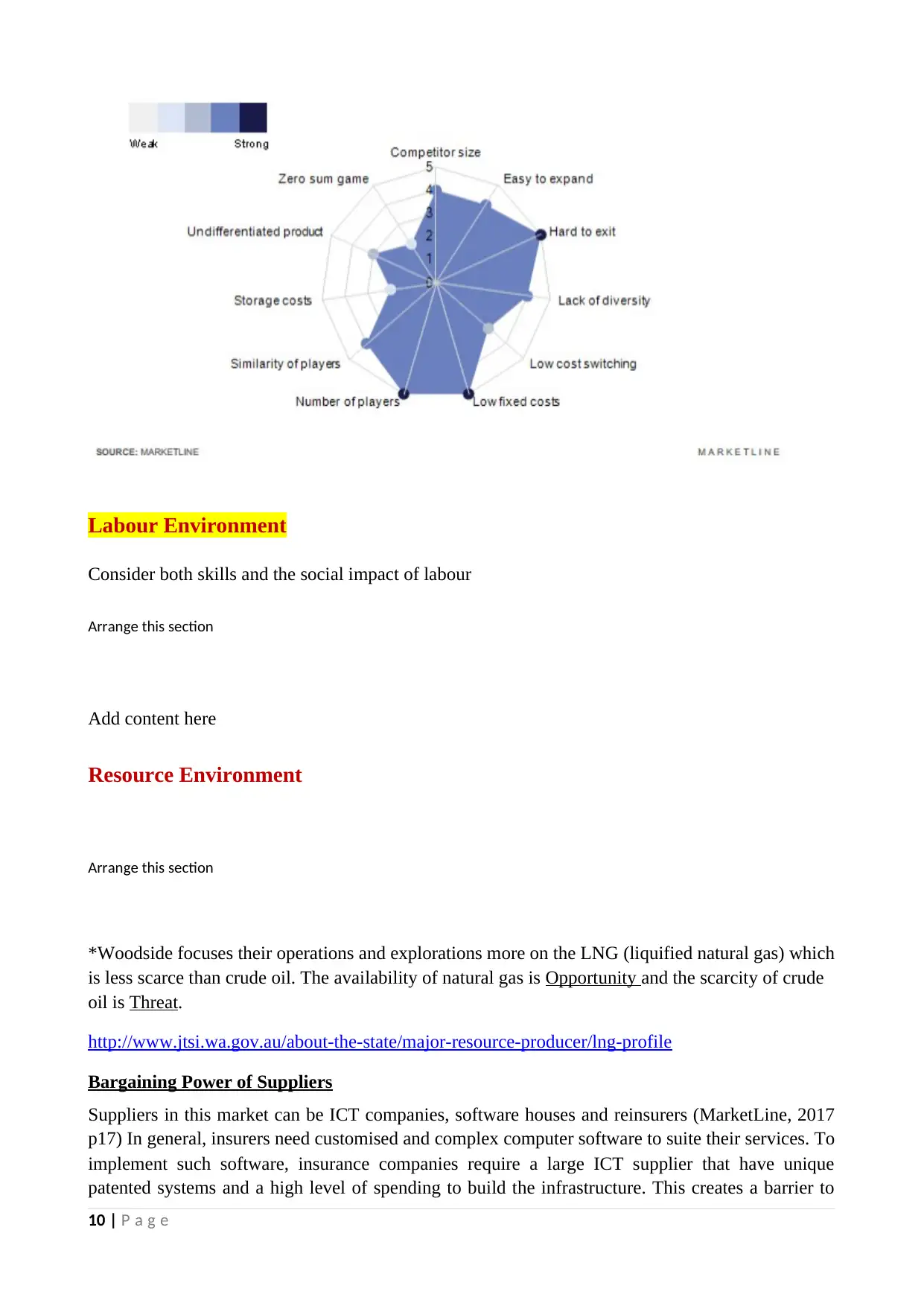
Labour Environment
Consider both skills and the social impact of labour
Arrange this section
Add content here
Resource Environment
Arrange this section
*Woodside focuses their operations and explorations more on the LNG (liquified natural gas) which
is less scarce than crude oil. The availability of natural gas is Opportunity and the scarcity of crude
oil is Threat.
http://www.jtsi.wa.gov.au/about-the-state/major-resource-producer/lng-profile
Bargaining Power of Suppliers
Suppliers in this market can be ICT companies, software houses and reinsurers (MarketLine, 2017
p17) In general, insurers need customised and complex computer software to suite their services. To
implement such software, insurance companies require a large ICT supplier that have unique
patented systems and a high level of spending to build the infrastructure. This creates a barrier to
10 | P a g e
Consider both skills and the social impact of labour
Arrange this section
Add content here
Resource Environment
Arrange this section
*Woodside focuses their operations and explorations more on the LNG (liquified natural gas) which
is less scarce than crude oil. The availability of natural gas is Opportunity and the scarcity of crude
oil is Threat.
http://www.jtsi.wa.gov.au/about-the-state/major-resource-producer/lng-profile
Bargaining Power of Suppliers
Suppliers in this market can be ICT companies, software houses and reinsurers (MarketLine, 2017
p17) In general, insurers need customised and complex computer software to suite their services. To
implement such software, insurance companies require a large ICT supplier that have unique
patented systems and a high level of spending to build the infrastructure. This creates a barrier to
10 | P a g e
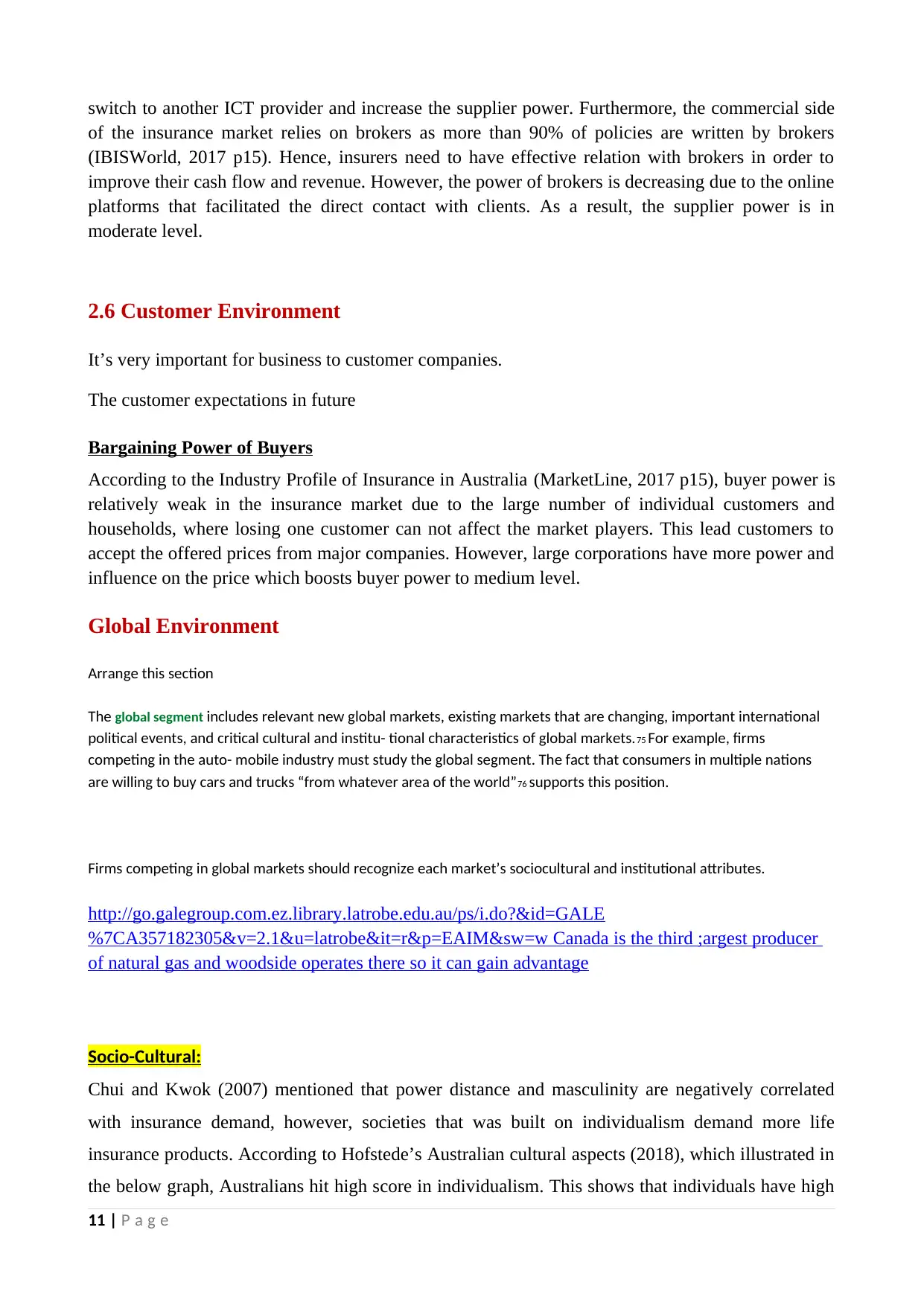
switch to another ICT provider and increase the supplier power. Furthermore, the commercial side
of the insurance market relies on brokers as more than 90% of policies are written by brokers
(IBISWorld, 2017 p15). Hence, insurers need to have effective relation with brokers in order to
improve their cash flow and revenue. However, the power of brokers is decreasing due to the online
platforms that facilitated the direct contact with clients. As a result, the supplier power is in
moderate level.
2.6 Customer Environment
It’s very important for business to customer companies.
The customer expectations in future
Bargaining Power of Buyers
According to the Industry Profile of Insurance in Australia (MarketLine, 2017 p15), buyer power is
relatively weak in the insurance market due to the large number of individual customers and
households, where losing one customer can not affect the market players. This lead customers to
accept the offered prices from major companies. However, large corporations have more power and
influence on the price which boosts buyer power to medium level.
Global Environment
Arrange this section
The global segment includes relevant new global markets, existing markets that are changing, important international
political events, and critical cultural and institu- tional characteristics of global markets.75 For example, firms
competing in the auto- mobile industry must study the global segment. The fact that consumers in multiple nations
are willing to buy cars and trucks “from whatever area of the world”76 supports this position.
Firms competing in global markets should recognize each market’s sociocultural and institutional attributes.
http://go.galegroup.com.ez.library.latrobe.edu.au/ps/i.do?&id=GALE
%7CA357182305&v=2.1&u=latrobe&it=r&p=EAIM&sw=w Canada is the third ;argest producer
of natural gas and woodside operates there so it can gain advantage
Socio-Cultural:
Chui and Kwok (2007) mentioned that power distance and masculinity are negatively correlated
with insurance demand, however, societies that was built on individualism demand more life
insurance products. According to Hofstede’s Australian cultural aspects (2018), which illustrated in
the below graph, Australians hit high score in individualism. This shows that individuals have high
11 | P a g e
of the insurance market relies on brokers as more than 90% of policies are written by brokers
(IBISWorld, 2017 p15). Hence, insurers need to have effective relation with brokers in order to
improve their cash flow and revenue. However, the power of brokers is decreasing due to the online
platforms that facilitated the direct contact with clients. As a result, the supplier power is in
moderate level.
2.6 Customer Environment
It’s very important for business to customer companies.
The customer expectations in future
Bargaining Power of Buyers
According to the Industry Profile of Insurance in Australia (MarketLine, 2017 p15), buyer power is
relatively weak in the insurance market due to the large number of individual customers and
households, where losing one customer can not affect the market players. This lead customers to
accept the offered prices from major companies. However, large corporations have more power and
influence on the price which boosts buyer power to medium level.
Global Environment
Arrange this section
The global segment includes relevant new global markets, existing markets that are changing, important international
political events, and critical cultural and institu- tional characteristics of global markets.75 For example, firms
competing in the auto- mobile industry must study the global segment. The fact that consumers in multiple nations
are willing to buy cars and trucks “from whatever area of the world”76 supports this position.
Firms competing in global markets should recognize each market’s sociocultural and institutional attributes.
http://go.galegroup.com.ez.library.latrobe.edu.au/ps/i.do?&id=GALE
%7CA357182305&v=2.1&u=latrobe&it=r&p=EAIM&sw=w Canada is the third ;argest producer
of natural gas and woodside operates there so it can gain advantage
Socio-Cultural:
Chui and Kwok (2007) mentioned that power distance and masculinity are negatively correlated
with insurance demand, however, societies that was built on individualism demand more life
insurance products. According to Hofstede’s Australian cultural aspects (2018), which illustrated in
the below graph, Australians hit high score in individualism. This shows that individuals have high
11 | P a g e
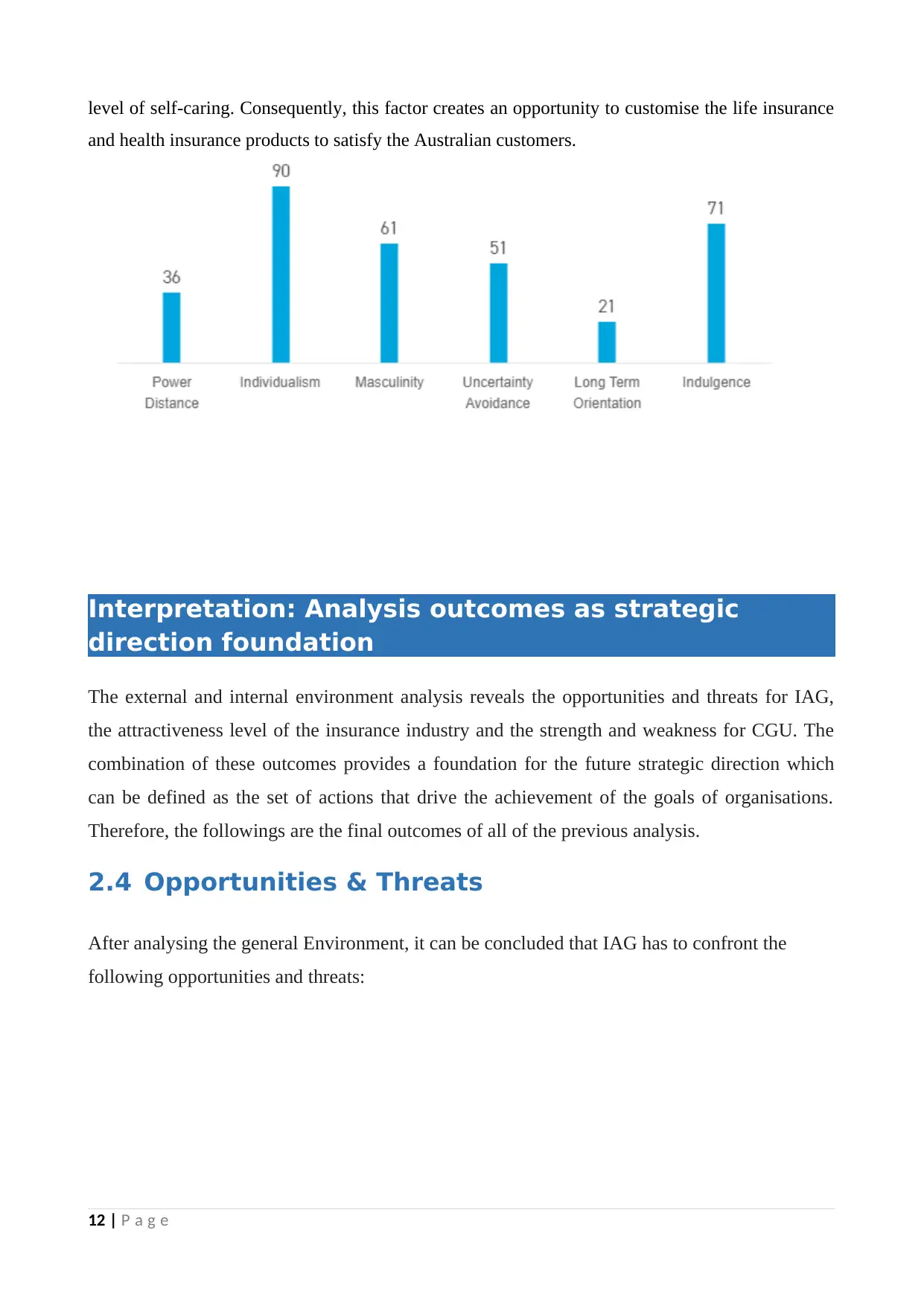
level of self-caring. Consequently, this factor creates an opportunity to customise the life insurance
and health insurance products to satisfy the Australian customers.
Interpretation: Analysis outcomes as strategic
direction foundation
The external and internal environment analysis reveals the opportunities and threats for IAG,
the attractiveness level of the insurance industry and the strength and weakness for CGU. The
combination of these outcomes provides a foundation for the future strategic direction which
can be defined as the set of actions that drive the achievement of the goals of organisations.
Therefore, the followings are the final outcomes of all of the previous analysis.
2.4 Opportunities & Threats
After analysing the general Environment, it can be concluded that IAG has to confront the
following opportunities and threats:
12 | P a g e
and health insurance products to satisfy the Australian customers.
Interpretation: Analysis outcomes as strategic
direction foundation
The external and internal environment analysis reveals the opportunities and threats for IAG,
the attractiveness level of the insurance industry and the strength and weakness for CGU. The
combination of these outcomes provides a foundation for the future strategic direction which
can be defined as the set of actions that drive the achievement of the goals of organisations.
Therefore, the followings are the final outcomes of all of the previous analysis.
2.4 Opportunities & Threats
After analysing the general Environment, it can be concluded that IAG has to confront the
following opportunities and threats:
12 | P a g e
Paraphrase This Document
Need a fresh take? Get an instant paraphrase of this document with our AI Paraphraser
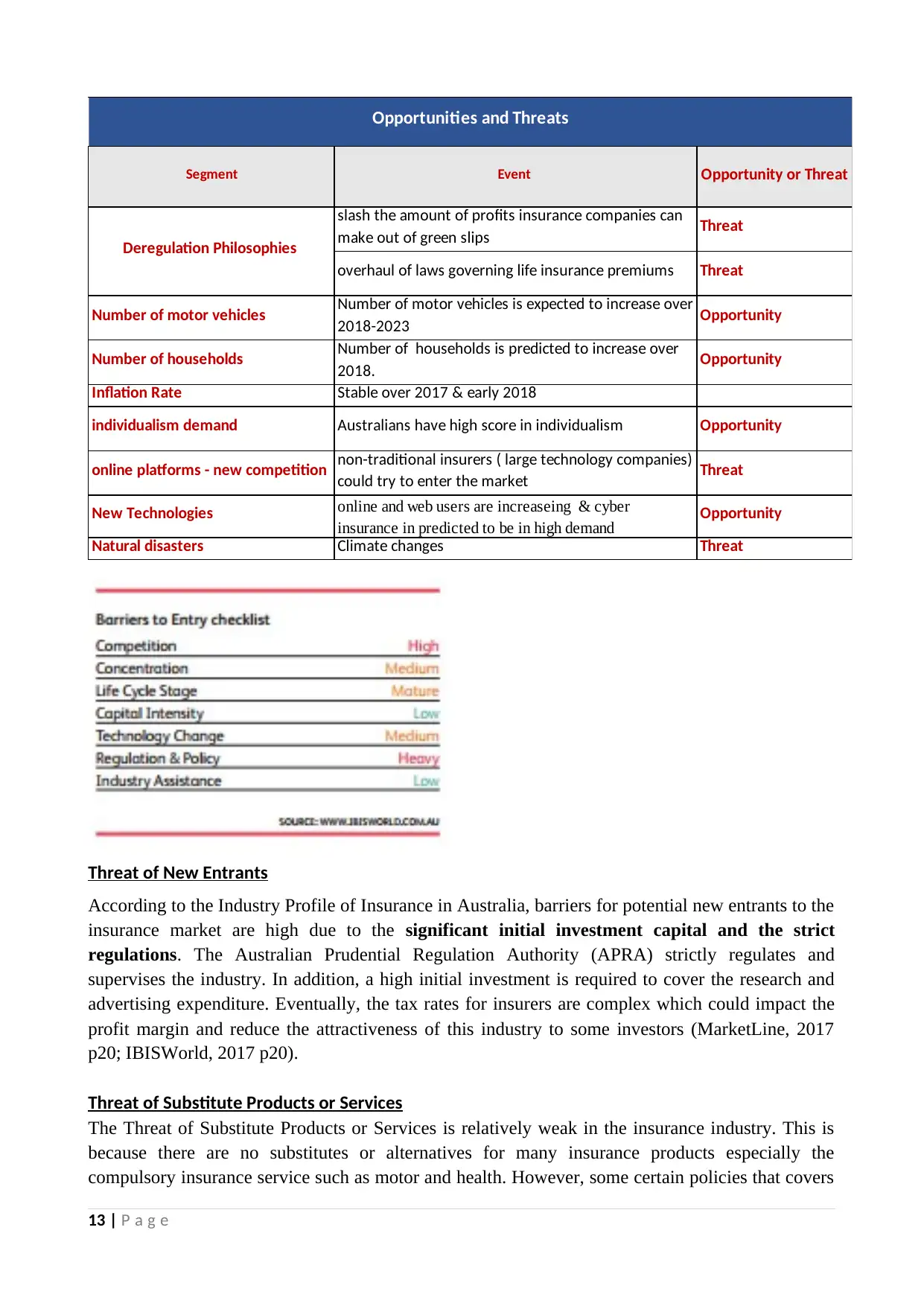
Segment Event Opportunity or Threat
slash the amount of profits insurance companies can
make out of green slips Threat
overhaul of laws governing life insurance premiums Threat
Number of motor vehicles Number of motor vehicles is expected to increase over
2018-2023 Opportunity
Number of households Number of households is predicted to increase over
2018. Opportunity
Inflation Rate Stable over 2017 & early 2018
individualism demand Australians have high score in individualism Opportunity
online platforms - new competition non-traditional insurers ( large technology companies)
could try to enter the market Threat
New Technologies online and web users are increaseing & cyber
insurance in predicted to be in high demand Opportunity
Natural disasters Climate changes Threat
Opportunities and Threats
Deregulation Philosophies
Threat of New Entrants
According to the Industry Profile of Insurance in Australia, barriers for potential new entrants to the
insurance market are high due to the significant initial investment capital and the strict
regulations. The Australian Prudential Regulation Authority (APRA) strictly regulates and
supervises the industry. In addition, a high initial investment is required to cover the research and
advertising expenditure. Eventually, the tax rates for insurers are complex which could impact the
profit margin and reduce the attractiveness of this industry to some investors (MarketLine, 2017
p20; IBISWorld, 2017 p20).
Threat of Substitute Products or Services
The Threat of Substitute Products or Services is relatively weak in the insurance industry. This is
because there are no substitutes or alternatives for many insurance products especially the
compulsory insurance service such as motor and health. However, some certain policies that covers
13 | P a g e
slash the amount of profits insurance companies can
make out of green slips Threat
overhaul of laws governing life insurance premiums Threat
Number of motor vehicles Number of motor vehicles is expected to increase over
2018-2023 Opportunity
Number of households Number of households is predicted to increase over
2018. Opportunity
Inflation Rate Stable over 2017 & early 2018
individualism demand Australians have high score in individualism Opportunity
online platforms - new competition non-traditional insurers ( large technology companies)
could try to enter the market Threat
New Technologies online and web users are increaseing & cyber
insurance in predicted to be in high demand Opportunity
Natural disasters Climate changes Threat
Opportunities and Threats
Deregulation Philosophies
Threat of New Entrants
According to the Industry Profile of Insurance in Australia, barriers for potential new entrants to the
insurance market are high due to the significant initial investment capital and the strict
regulations. The Australian Prudential Regulation Authority (APRA) strictly regulates and
supervises the industry. In addition, a high initial investment is required to cover the research and
advertising expenditure. Eventually, the tax rates for insurers are complex which could impact the
profit margin and reduce the attractiveness of this industry to some investors (MarketLine, 2017
p20; IBISWorld, 2017 p20).
Threat of Substitute Products or Services
The Threat of Substitute Products or Services is relatively weak in the insurance industry. This is
because there are no substitutes or alternatives for many insurance products especially the
compulsory insurance service such as motor and health. However, some certain policies that covers
13 | P a g e
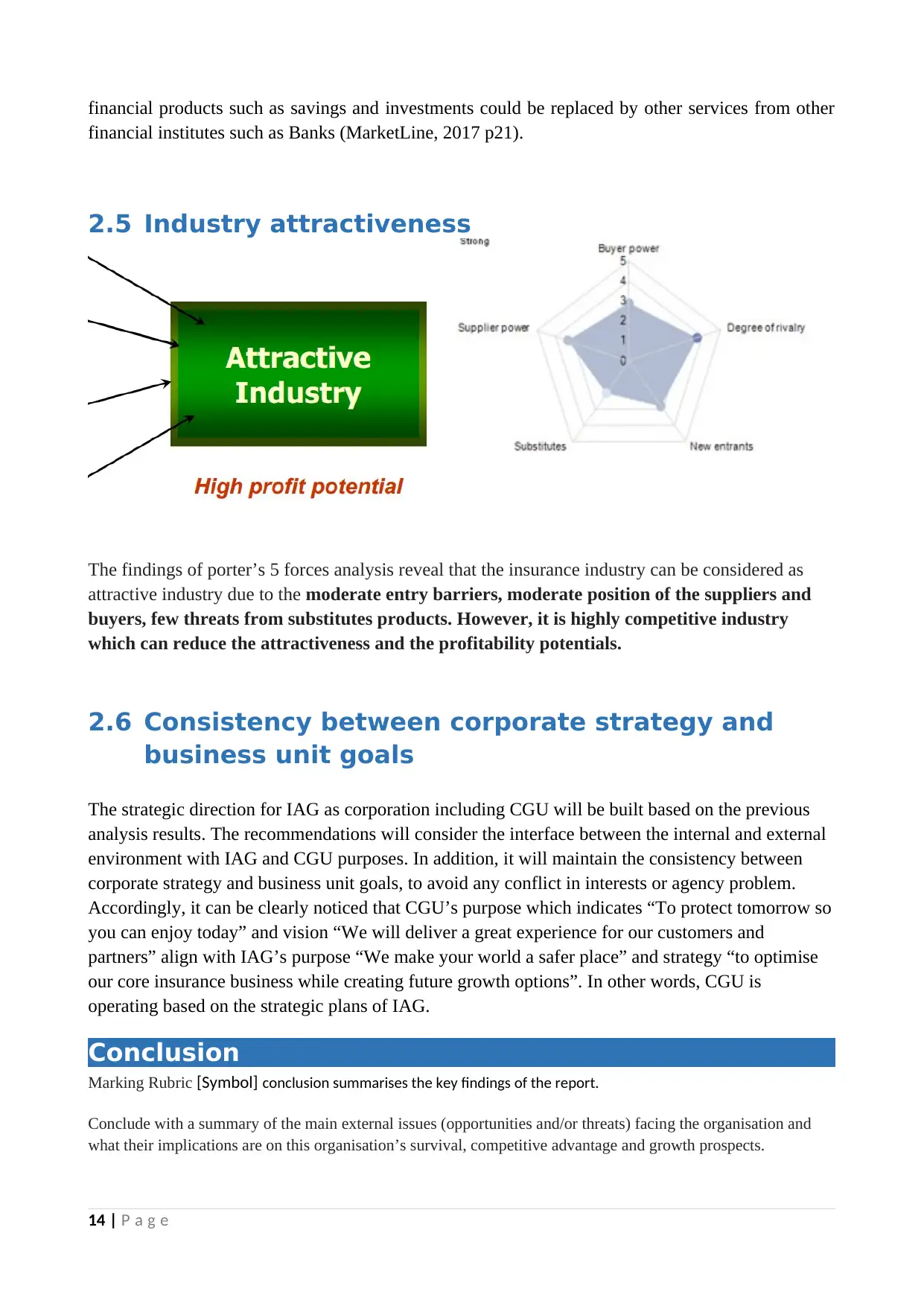
financial products such as savings and investments could be replaced by other services from other
financial institutes such as Banks (MarketLine, 2017 p21).
2.5 Industry attractiveness
The findings of porter’s 5 forces analysis reveal that the insurance industry can be considered as
attractive industry due to the moderate entry barriers, moderate position of the suppliers and
buyers, few threats from substitutes products. However, it is highly competitive industry
which can reduce the attractiveness and the profitability potentials.
2.6 Consistency between corporate strategy and
business unit goals
The strategic direction for IAG as corporation including CGU will be built based on the previous
analysis results. The recommendations will consider the interface between the internal and external
environment with IAG and CGU purposes. In addition, it will maintain the consistency between
corporate strategy and business unit goals, to avoid any conflict in interests or agency problem.
Accordingly, it can be clearly noticed that CGU’s purpose which indicates “To protect tomorrow so
you can enjoy today” and vision “We will deliver a great experience for our customers and
partners” align with IAG’s purpose “We make your world a safer place” and strategy “to optimise
our core insurance business while creating future growth options”. In other words, CGU is
operating based on the strategic plans of IAG.
Conclusion
Marking Rubric [Symbol] conclusion summarises the key findings of the report.
Conclude with a summary of the main external issues (opportunities and/or threats) facing the organisation and
what their implications are on this organisation’s survival, competitive advantage and growth prospects.
4. Conclusion
14 | P a g e
financial institutes such as Banks (MarketLine, 2017 p21).
2.5 Industry attractiveness
The findings of porter’s 5 forces analysis reveal that the insurance industry can be considered as
attractive industry due to the moderate entry barriers, moderate position of the suppliers and
buyers, few threats from substitutes products. However, it is highly competitive industry
which can reduce the attractiveness and the profitability potentials.
2.6 Consistency between corporate strategy and
business unit goals
The strategic direction for IAG as corporation including CGU will be built based on the previous
analysis results. The recommendations will consider the interface between the internal and external
environment with IAG and CGU purposes. In addition, it will maintain the consistency between
corporate strategy and business unit goals, to avoid any conflict in interests or agency problem.
Accordingly, it can be clearly noticed that CGU’s purpose which indicates “To protect tomorrow so
you can enjoy today” and vision “We will deliver a great experience for our customers and
partners” align with IAG’s purpose “We make your world a safer place” and strategy “to optimise
our core insurance business while creating future growth options”. In other words, CGU is
operating based on the strategic plans of IAG.
Conclusion
Marking Rubric [Symbol] conclusion summarises the key findings of the report.
Conclude with a summary of the main external issues (opportunities and/or threats) facing the organisation and
what their implications are on this organisation’s survival, competitive advantage and growth prospects.
4. Conclusion
14 | P a g e
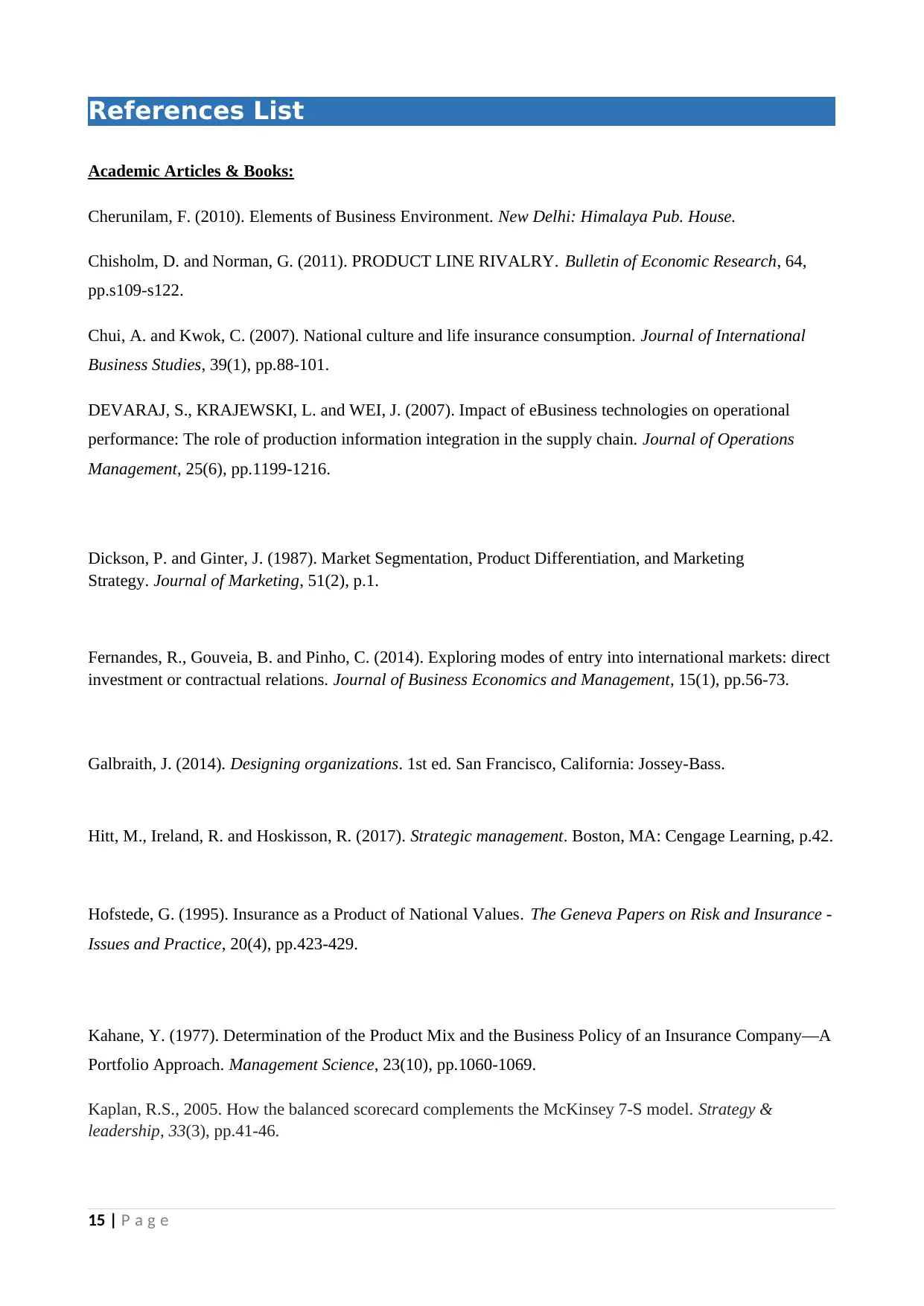
References List
Academic Articles & Books:
Cherunilam, F. (2010). Elements of Business Environment. New Delhi: Himalaya Pub. House.
Chisholm, D. and Norman, G. (2011). PRODUCT LINE RIVALRY. Bulletin of Economic Research, 64,
pp.s109-s122.
Chui, A. and Kwok, C. (2007). National culture and life insurance consumption. Journal of International
Business Studies, 39(1), pp.88-101.
DEVARAJ, S., KRAJEWSKI, L. and WEI, J. (2007). Impact of eBusiness technologies on operational
performance: The role of production information integration in the supply chain. Journal of Operations
Management, 25(6), pp.1199-1216.
Dickson, P. and Ginter, J. (1987). Market Segmentation, Product Differentiation, and Marketing
Strategy. Journal of Marketing, 51(2), p.1.
Fernandes, R., Gouveia, B. and Pinho, C. (2014). Exploring modes of entry into international markets: direct
investment or contractual relations. Journal of Business Economics and Management, 15(1), pp.56-73.
Galbraith, J. (2014). Designing organizations. 1st ed. San Francisco, California: Jossey-Bass.
Hitt, M., Ireland, R. and Hoskisson, R. (2017). Strategic management. Boston, MA: Cengage Learning, p.42.
Hofstede, G. (1995). Insurance as a Product of National Values. The Geneva Papers on Risk and Insurance -
Issues and Practice, 20(4), pp.423-429.
Kahane, Y. (1977). Determination of the Product Mix and the Business Policy of an Insurance Company—A
Portfolio Approach. Management Science, 23(10), pp.1060-1069.
Kaplan, R.S., 2005. How the balanced scorecard complements the McKinsey 7-S model. Strategy &
leadership, 33(3), pp.41-46.
15 | P a g e
Academic Articles & Books:
Cherunilam, F. (2010). Elements of Business Environment. New Delhi: Himalaya Pub. House.
Chisholm, D. and Norman, G. (2011). PRODUCT LINE RIVALRY. Bulletin of Economic Research, 64,
pp.s109-s122.
Chui, A. and Kwok, C. (2007). National culture and life insurance consumption. Journal of International
Business Studies, 39(1), pp.88-101.
DEVARAJ, S., KRAJEWSKI, L. and WEI, J. (2007). Impact of eBusiness technologies on operational
performance: The role of production information integration in the supply chain. Journal of Operations
Management, 25(6), pp.1199-1216.
Dickson, P. and Ginter, J. (1987). Market Segmentation, Product Differentiation, and Marketing
Strategy. Journal of Marketing, 51(2), p.1.
Fernandes, R., Gouveia, B. and Pinho, C. (2014). Exploring modes of entry into international markets: direct
investment or contractual relations. Journal of Business Economics and Management, 15(1), pp.56-73.
Galbraith, J. (2014). Designing organizations. 1st ed. San Francisco, California: Jossey-Bass.
Hitt, M., Ireland, R. and Hoskisson, R. (2017). Strategic management. Boston, MA: Cengage Learning, p.42.
Hofstede, G. (1995). Insurance as a Product of National Values. The Geneva Papers on Risk and Insurance -
Issues and Practice, 20(4), pp.423-429.
Kahane, Y. (1977). Determination of the Product Mix and the Business Policy of an Insurance Company—A
Portfolio Approach. Management Science, 23(10), pp.1060-1069.
Kaplan, R.S., 2005. How the balanced scorecard complements the McKinsey 7-S model. Strategy &
leadership, 33(3), pp.41-46.
15 | P a g e
Secure Best Marks with AI Grader
Need help grading? Try our AI Grader for instant feedback on your assignments.
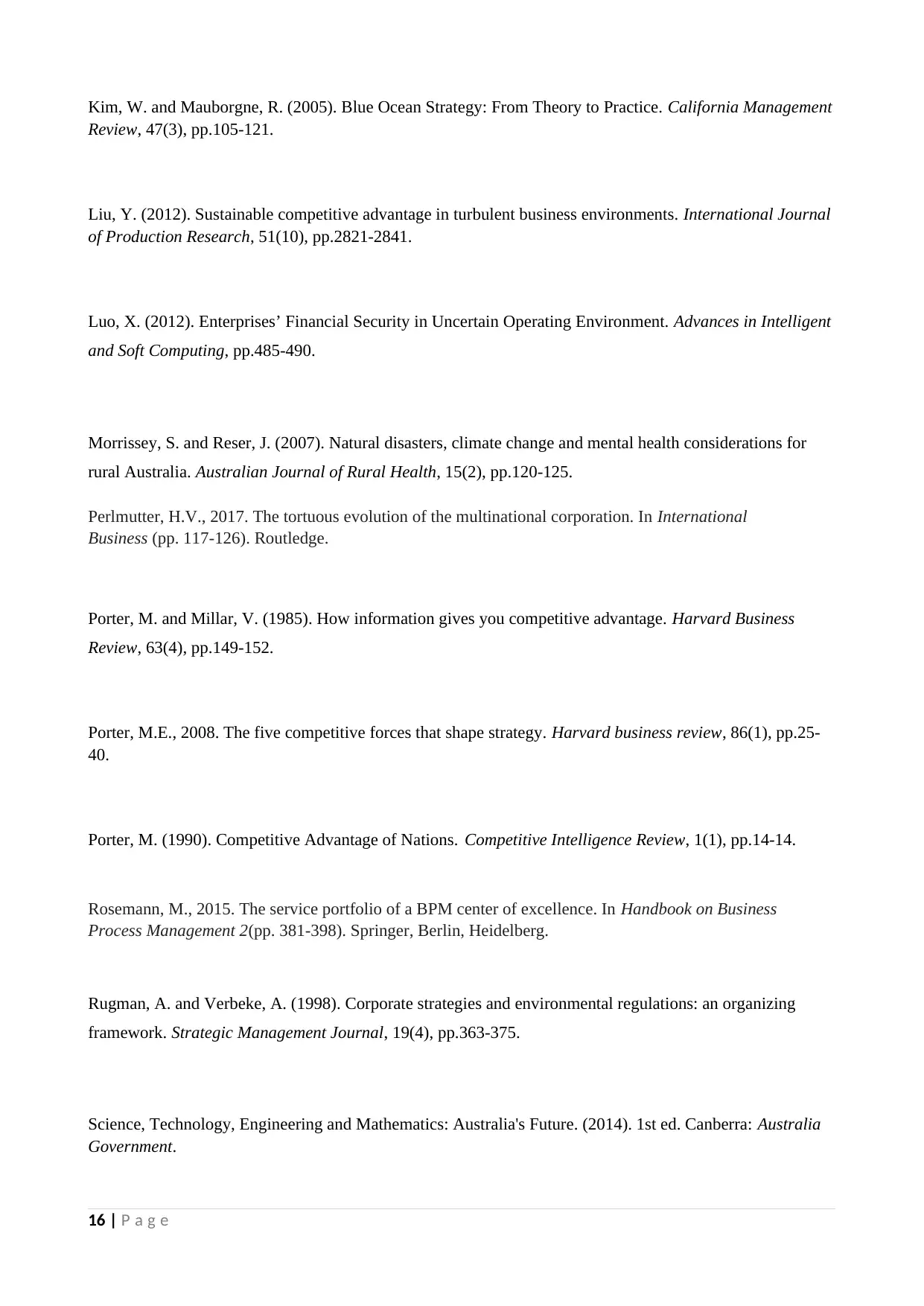
Kim, W. and Mauborgne, R. (2005). Blue Ocean Strategy: From Theory to Practice. California Management
Review, 47(3), pp.105-121.
Liu, Y. (2012). Sustainable competitive advantage in turbulent business environments. International Journal
of Production Research, 51(10), pp.2821-2841.
Luo, X. (2012). Enterprises’ Financial Security in Uncertain Operating Environment. Advances in Intelligent
and Soft Computing, pp.485-490.
Morrissey, S. and Reser, J. (2007). Natural disasters, climate change and mental health considerations for
rural Australia. Australian Journal of Rural Health, 15(2), pp.120-125.
Perlmutter, H.V., 2017. The tortuous evolution of the multinational corporation. In International
Business (pp. 117-126). Routledge.
Porter, M. and Millar, V. (1985). How information gives you competitive advantage. Harvard Business
Review, 63(4), pp.149-152.
Porter, M.E., 2008. The five competitive forces that shape strategy. Harvard business review, 86(1), pp.25-
40.
Porter, M. (1990). Competitive Advantage of Nations. Competitive Intelligence Review, 1(1), pp.14-14.
Rosemann, M., 2015. The service portfolio of a BPM center of excellence. In Handbook on Business
Process Management 2(pp. 381-398). Springer, Berlin, Heidelberg.
Rugman, A. and Verbeke, A. (1998). Corporate strategies and environmental regulations: an organizing
framework. Strategic Management Journal, 19(4), pp.363-375.
Science, Technology, Engineering and Mathematics: Australia's Future. (2014). 1st ed. Canberra: Australia
Government.
16 | P a g e
Review, 47(3), pp.105-121.
Liu, Y. (2012). Sustainable competitive advantage in turbulent business environments. International Journal
of Production Research, 51(10), pp.2821-2841.
Luo, X. (2012). Enterprises’ Financial Security in Uncertain Operating Environment. Advances in Intelligent
and Soft Computing, pp.485-490.
Morrissey, S. and Reser, J. (2007). Natural disasters, climate change and mental health considerations for
rural Australia. Australian Journal of Rural Health, 15(2), pp.120-125.
Perlmutter, H.V., 2017. The tortuous evolution of the multinational corporation. In International
Business (pp. 117-126). Routledge.
Porter, M. and Millar, V. (1985). How information gives you competitive advantage. Harvard Business
Review, 63(4), pp.149-152.
Porter, M.E., 2008. The five competitive forces that shape strategy. Harvard business review, 86(1), pp.25-
40.
Porter, M. (1990). Competitive Advantage of Nations. Competitive Intelligence Review, 1(1), pp.14-14.
Rosemann, M., 2015. The service portfolio of a BPM center of excellence. In Handbook on Business
Process Management 2(pp. 381-398). Springer, Berlin, Heidelberg.
Rugman, A. and Verbeke, A. (1998). Corporate strategies and environmental regulations: an organizing
framework. Strategic Management Journal, 19(4), pp.363-375.
Science, Technology, Engineering and Mathematics: Australia's Future. (2014). 1st ed. Canberra: Australia
Government.
16 | P a g e
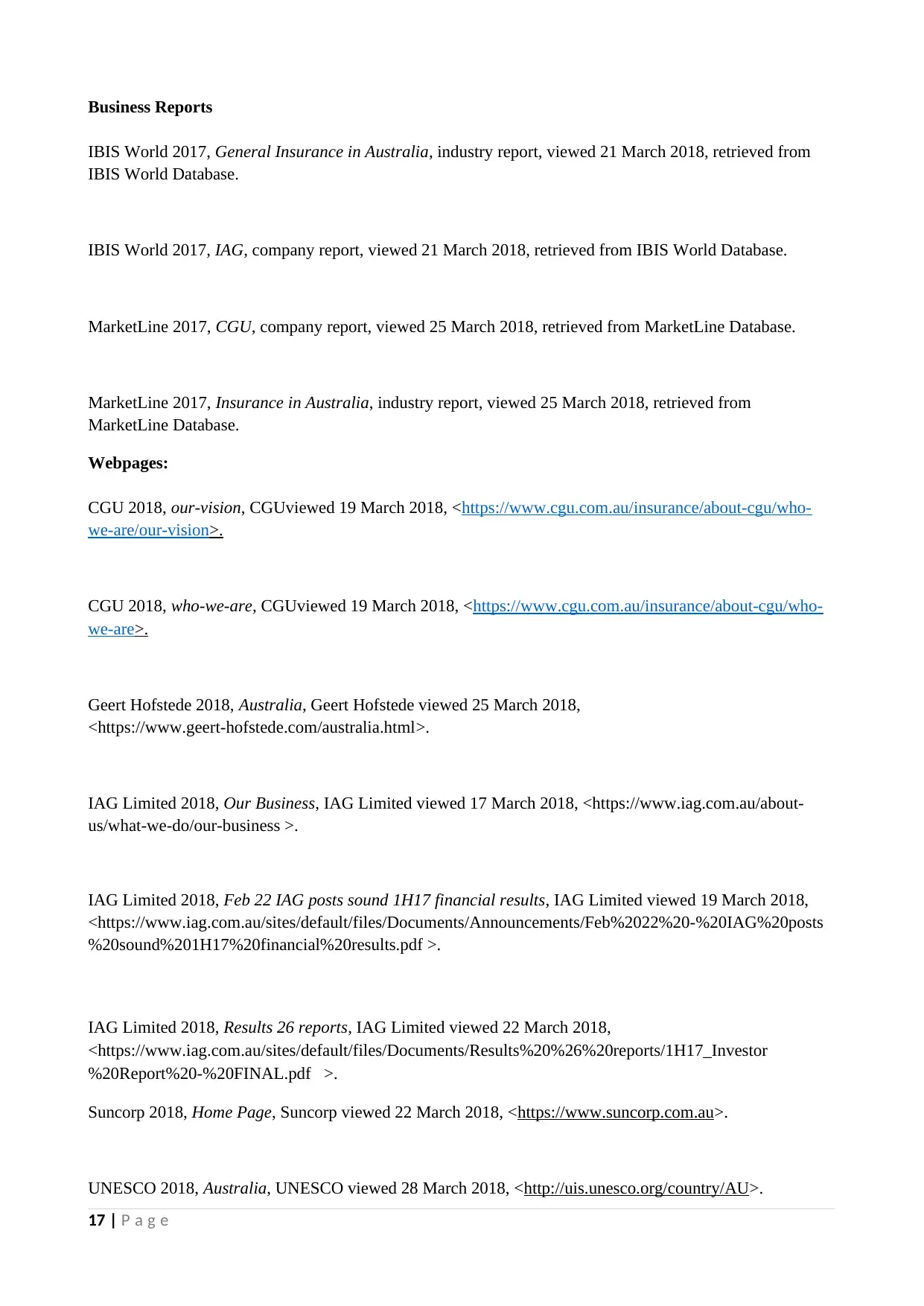
Business Reports
IBIS World 2017, General Insurance in Australia, industry report, viewed 21 March 2018, retrieved from
IBIS World Database.
IBIS World 2017, IAG, company report, viewed 21 March 2018, retrieved from IBIS World Database.
MarketLine 2017, CGU, company report, viewed 25 March 2018, retrieved from MarketLine Database.
MarketLine 2017, Insurance in Australia, industry report, viewed 25 March 2018, retrieved from
MarketLine Database.
Webpages:
CGU 2018, our-vision, CGUviewed 19 March 2018, <https://www.cgu.com.au/insurance/about-cgu/who-
we-are/our-vision>.
CGU 2018, who-we-are, CGUviewed 19 March 2018, <https://www.cgu.com.au/insurance/about-cgu/who-
we-are>.
Geert Hofstede 2018, Australia, Geert Hofstede viewed 25 March 2018,
<https://www.geert-hofstede.com/australia.html>.
IAG Limited 2018, Our Business, IAG Limited viewed 17 March 2018, <https://www.iag.com.au/about-
us/what-we-do/our-business >.
IAG Limited 2018, Feb 22 IAG posts sound 1H17 financial results, IAG Limited viewed 19 March 2018,
<https://www.iag.com.au/sites/default/files/Documents/Announcements/Feb%2022%20-%20IAG%20posts
%20sound%201H17%20financial%20results.pdf >.
IAG Limited 2018, Results 26 reports, IAG Limited viewed 22 March 2018,
<https://www.iag.com.au/sites/default/files/Documents/Results%20%26%20reports/1H17_Investor
%20Report%20-%20FINAL.pdf >.
Suncorp 2018, Home Page, Suncorp viewed 22 March 2018, <https://www.suncorp.com.au>.
UNESCO 2018, Australia, UNESCO viewed 28 March 2018, <http://uis.unesco.org/country/AU>.
17 | P a g e
IBIS World 2017, General Insurance in Australia, industry report, viewed 21 March 2018, retrieved from
IBIS World Database.
IBIS World 2017, IAG, company report, viewed 21 March 2018, retrieved from IBIS World Database.
MarketLine 2017, CGU, company report, viewed 25 March 2018, retrieved from MarketLine Database.
MarketLine 2017, Insurance in Australia, industry report, viewed 25 March 2018, retrieved from
MarketLine Database.
Webpages:
CGU 2018, our-vision, CGUviewed 19 March 2018, <https://www.cgu.com.au/insurance/about-cgu/who-
we-are/our-vision>.
CGU 2018, who-we-are, CGUviewed 19 March 2018, <https://www.cgu.com.au/insurance/about-cgu/who-
we-are>.
Geert Hofstede 2018, Australia, Geert Hofstede viewed 25 March 2018,
<https://www.geert-hofstede.com/australia.html>.
IAG Limited 2018, Our Business, IAG Limited viewed 17 March 2018, <https://www.iag.com.au/about-
us/what-we-do/our-business >.
IAG Limited 2018, Feb 22 IAG posts sound 1H17 financial results, IAG Limited viewed 19 March 2018,
<https://www.iag.com.au/sites/default/files/Documents/Announcements/Feb%2022%20-%20IAG%20posts
%20sound%201H17%20financial%20results.pdf >.
IAG Limited 2018, Results 26 reports, IAG Limited viewed 22 March 2018,
<https://www.iag.com.au/sites/default/files/Documents/Results%20%26%20reports/1H17_Investor
%20Report%20-%20FINAL.pdf >.
Suncorp 2018, Home Page, Suncorp viewed 22 March 2018, <https://www.suncorp.com.au>.
UNESCO 2018, Australia, UNESCO viewed 28 March 2018, <http://uis.unesco.org/country/AU>.
17 | P a g e
1 out of 18
Related Documents
Your All-in-One AI-Powered Toolkit for Academic Success.
+13062052269
info@desklib.com
Available 24*7 on WhatsApp / Email
![[object Object]](/_next/static/media/star-bottom.7253800d.svg)
Unlock your academic potential
© 2024 | Zucol Services PVT LTD | All rights reserved.





